Motors & Man Stuff
The Home of all Your Manswers!

Suspension Travel and Motion Ratio: Explained
- Motorsport Tuning Guides
If you’re into motorsport or have a passion for cars, you’ve likely heard the term “suspension travel” before. But what does it actually mean, and how does it affect your car’s performance? In this article, we’ll delve into suspension travel and its relationship with motion ratio, which is crucial for a proper understanding of suspension setups.
Understanding Suspension Travel
Factors affecting suspension travel, suspension travel in different applications, compression vs. rebound travel, understanding motion ratio, the importance of wheel rate, q: what is suspension travel, q: how does suspension travel affect a car’s performance, q: what is motion ratio, q: what is wheel rate.
Simply put, suspension travel refers to how far a component of the suspension can move over the full extent of its movement range. In most cases, we’re interested in the vertical wheel travel, which is the distance that the wheel can travel from full droop to full compression. However, suspension travel can also refer to any other part of the suspension we might be interested in.
There are many factors that go into deciding how much suspension travel we need. Two of the most important and interrelated ones are the required stiffness of the suspension we’re working with and the roughness of the surface that the vehicle is running on. These factors will be discussed in detail later in the course.
The required suspension travel varies greatly depending on the application. For instance, a stadium truck running on rough terrain needs a large amount of vertical wheel travel to absorb the energy of a landing and reduce the forces involved. On the other hand, a high downforce single-seater running on a smooth surface requires less travel to keep things like camber, caster, and toe within suitable limits as the car negotiates the circuit.
Another important aspect of suspension travel is how much of the travel is available in compression versus rebound. A sensible starting point is to allow for approximately 2/3 of the available travel in compression and 1/3 in rebound. Having the majority of our suspension travel available on compression allows the suspension to absorb undulations in the road surface, while the rebound travel is there to keep the tires in contact with the road as the chassis heaves, rolls, and pitches.
Motion ratio is closely related to suspension travel and describes how much one component moves relative to the other when they’re linked together. We’re interested in the motion ratio between a number of different elements, but the most common is between the wheel and spring and damper assembly. In almost all cases, this ratio will not be 1:1, and the value of the motion ratio will generally vary as the suspension moves through its travel.
When comparing spring rates between different cars, it’s important to understand that the motion ratio between the wheel and the spring isn’t identical. We care about the effective spring rate at the wheel, which is generally referred to as the wheel rate. By using the motion ratio, we can calculate the wheel rate so we can make more relevant comparisons between cars with different suspension systems.
A: Suspension travel refers to how far a component of the suspension can move over the full extent of its movement range.
A: Suspension travel affects a car’s performance by absorbing energy, reducing forces, and keeping the tires in contact with the road.
A: Motion ratio describes how much one component moves relative to the other when they’re linked together.
A: Wheel rate is the effective spring rate at the wheel, which takes into account the motion ratio between the wheel and the spring.
In conclusion, suspension travel and motion ratio are crucial aspects of suspension design and tuning that can greatly affect a car’s performance. The required suspension travel varies depending on the application, and a proper understanding of motion ratio is necessary for comparing spring rates between different cars. By optimizing suspension travel and motion ratio, you can improve your car’s handling and performance on the road or track.
- Suspension Travel: What Is It and How Does It Affect Your Car’s Performance? – https://www.autosimple.com/suspension-travel-what-is-it-and-how-does-it-affect-your-cars-performance/
- The Importance of Motion Ratio in Suspension Design – https://www.nolimitmotorsport.com/blog/the-importance-of-motion-ratio-in-suspension-design/
- How to Calculate Wheel Rate: A Simple Guide for Racing Suspension – https://www.speedwaymotors.com/the-toolbox/how-to-calculate-wheel-rate/31488
Related Stories
- Vehicle DIY & Tutorials
Drifting 101: Your Ultimate Guide to Basic Drift Modifications & Drift Day Preparations
Turbo flange dimensions: your complete guide to t25, t3, and t04, unlocking the power of anti-lag: how it works and how to apply it to your car.
INTRODUCTION TO SUSPENSION
Why do cars have suspension?
The object of a suspension system is to isolate the body and its occupants from the irregularities of the road surface. Ideally the body should ride level and without vertical motion’ however bumpy the road surface. Another important feature of suspension is that it should keep the tires on the ground all the time. If there were no suspension the tires would tend to lift off the ground every time they passed over a bump at the same time, the shock as the wheels left the ground’ and then came down again, would be transmitted directly to the passengers.
What does a suspension?
Ideally the suspension should allow the wheels to move up and down so that they follow the undulations in the road’ while the body rides level. The first requirement therefore is that the wheels should be able to move vertically relative to the body. Every suspension has this wheel travel, which must be accommodated by some means.
How is the wheel movement accommodated?
Springs are normally used (Figure 1.1). As the tire strikes a bump in the road, so a vertical force is applied to the spring’ which is compressed or deflected. Therefore the wheel moves vertically relative to the body, and the tire maintains contact with the road surface. However, some of this force is transmitted through the spring to the body, which also tends to rise. If the springs are very ‘soft’ (i.e. have relatively low spring rates) the body rises little, but if the springs are very stiff the body rises quite a bit, depending on the severity of the bump. For a good ride, therefore, the springs should be soft.
Do soft springs have any disadvantages?
Although soft springs give a good ride in most circumstances, they allow the body to roll a lot during cornering. In practice, spring rates are a compromise between the requirements of ride and handling.
Why does a car roll?
When a car turns a corner, centrifugal force acts on the body and tends to push it outwards. However, this force is resisted by the tires, which grip the road; as a result, the body rolls about its suspension (Figure 1.2).
What is the disadvantage of roll?
When the car rolls excessively it is more difficult for the driver to control its direction. Also, when the car emerges from the corner and the body rolls back to the upright position, it will roll past the upright position if roll is excessive, and will take some time to right itself. Excessive roll can also make the wheels adopt unfavorable angles, depending on the type of suspension fitted.
Are any other components needed?
In its simplest form the suspension consists purely of the springs and their anchorages. However, when a spring is deflected it attempts to return to its normal position immediately, and if left to itself it goes past the normal position and then back again. It would take a number of these oscillations absorb the stored energy, and only then would the spring return to the normal position.
How is spring oscillation controlled?
Dampers are used to cut down these oscillations so that, after going past the normal position once, the spring soon returns to normal.
SPRINGING REQUIREMENTS
What are the basic requirements of a spring?
Ideally a spring should be arranged so that it is ‘soft’ enough to give a good ride; yet it should be able to absorb all the energy resulting from road shocks without using up all the wheel travel, and it should be stiff enough to prevent excessive roll on corners.
Are all these possible?
Suspension is a compromise between conflicting requirements, but it is possible to gain a good level of performance in all respects, although this can be expensive. First, however, it is necessary to appreciate how these parameters are measured, and how the important figures are calculated.
How is the ‘softness’ of a spring measured?
Every spring has a rate, which is an indication of how much the spring is deflected by load. This is normally indicated as load per unit deflection, given in Newton ’s per millimeter (or pounds-force per inch). However, when it comes to ride, the weight being carried has to be taken into account as well as the spring rate. For example, if a small mass is applied to a spring there is hardly any deflection, whereas a big mass applied to the same spring will give a big deflection, lithe mass is then bounced on the spring, the small mass moves very little, very quickly, whereas the big mass moves up and down quite a long way, but slowly. The amount the mass deflects the spring is called the static deflection, and the rate at which the mass bounces up and down is the natural frequency or periodicity of the spring-mass system.
How is the static deflection found?
The static deflection, D mm, is simply the mass carried divided by the spring rate, i.e. D = mass/spring rate.
How is the natural frequency found?
This is a bit more involved, in that the natural frequency = 30/ cycles/mm, where D is the static deflection, in meters.
What are typical values?
Values vary according to the type of car. For a small saloon the static deflection is often 110-140 mm, and the equivalent natural frequency between 90 and 80 cycles/mm. For a medium-size saloon, the figures might be 130-180 mm, between 85 and 70 cycles/mm; for a large saloon, 180-280 mm, between 70 and 55 cycles/mm. With some very advanced suspensions, figures of over 280 mm or under 55 cycles/mm are obtained.
Do these figures vary with load?
The actual figures for a car vary according to the load carried. When the car is in the kerb condition the frequencies will normally be higher than when it is fully laden, with four people and their luggage in the car. Also, there is normally little difference in the amount of weight carried by the front springs, laden or unladen, but a big difference at the back.
Typical figures for a medium-size saloon are
At the front the difference is small enough to be ignored, but at the rear it makes the ride firmer unladen than when fully laden. Ideally the frequency should remain constant, irrespective of loading, and at a satisfactorily low level.
Can a constant frequency be obtained?
A constant frequency can be obtained only if the spring rate increases in proportion as the load it carries increases. Of course the balance can also be improved by arranging for the increase in weight to be applied equally to the front and rear springs. In practice this is very difficult to arrange.
How is the stiffness of the spring measured in roll?
Basically, the stiffer the spring, the less the car will roll, although the spacing of the springs and the roll-centre height also affect the amount the car rolls. The roll stifThess, which is the measure of the way in which the springs resist roll, is given by:
Roll stiffness = C w x t x 0.08729 N m/deg
for independent suspensions, where C w is the spring rate at the wheel, known as the wheel rate, and t is the track of the car. For beam-axle suspensions:
Roll stiffness = Cs x s 2 x 0.08729 N m/deg
where C s is the spring rate, and s is the spring base, i.e. distance between the effective positions of the left- and right-hand springs.
In simple terms, this means that an increase in either the spring rate or the spring base (or track) will increase resistance to roll, and that more can be gained by increasing the spring base (or track) than by increasing the spring rate.
How can the spring base be increased?
With a beam axle, the spring base is the distance between the springs (Figure 3.1), and the practical width is determined by the necessity of giving clearance around the wheels and brakes.
In practice, this means that the spring base is about 70-80 percent of the track, and that the wheel rate in roll is only about 50-70 per cent of the wheel rate in bump. There is little that can be done to increase the spring base with beam axles.
Is independent suspension better, then?
A better balance between ride and roll stiffness can be obtained with independent suspension, because the wheel rate in bump is the same as it is in roll. So, assuming that the linkages are equally good and that the roll centre of the independent suspension is not very low (see later), independent suspension has this one definite advantage.
Can roll stiffness be increased in any other way?
The addition of an anti-roll bar increases roll stiffness and reduces roll. An anti-roll bar is a horizontal, transverse torsion bar, normally mounted in two rubber bushes on the body. The ends are turned round to form levers, and are attached to the suspension member or axle, either directly or through drop-links. When the front wheels strike an undulation in the road so that both springs are deflected, the anti-roll bar merely rotates, so it is not deflected and exerts no force on the body. However, when the car goes round a corner, and rolls, one lever goes upwards and the other downwards, so the anti-roll bar is twisted. The bar resists, and tries to twist the car body back to the vertical position. Generally, then, the .addition of an anti-roll bar reduces roll but does not affect the ride. The stiffness of an anti-roll bar is usually referred to as its spring rate in roll.
Does the anti-roll bar have any side effects?
Quite often only one wheel hits a bump, and in this case the anti-roll bar does alter the spring rate. What happens is that the anti-roll bar twists as the wheel is raised but, since the other wheel does not move, the bar twists over its whole length (in roll, the bar is twisted from both ends, as it were, so its effective length is half the actual length). This situation, called single-wheel bump, has a higher bump rate than when both wheels move upwards together. For example, if the spring rate of the anti-roll bar is 7 N/mm and the wheel rate of the spring is 20 N/mm, then on single- wheel bump the rate is 20 + 7/2 = 23.5 N/mm. If the proportions are of this order, the passenger will hardly notice the difference. However, if the spring rate is very low and the anti- roll bar is very stiff, a single-wheel bump will tend to rock the car, inducing what is called a roll-rock condition, which can be uncomfortable.
Can the resistance to roll be altered in any other way?
Although the roll stiffness depends purely on the spring rate in roll, the anti-roll bar and the spring base, the resistance to roll also depends on the roll centre. But in essence the higher the roll centre, the less the vehicle rolls. Why does a high rod centre reduce roll?
When a vehicle corners, the centrifugal force acts through the centre of gravity, and it is this that makes the vehicle roll. However, if we consider the front of the car (i.e. the front wheels, and the amount of the car they carry), then the body or portion of the body must roll about some point, and that is the roll centre (Figure 3.2). The force making the vehicle roll is called the tilting moment, which is the tilting force times its effective height. The effective height is the distance, h, from the centre of gravity of the vehicle to the roll centre. Therefore, to reduce roll, h should be kept to the minimum. If the two were at the same height, the car would not roll at all. It is for this reason that the centre of gravity of a racing car is as low as possible.
Apart from the problems with roll, are there any other limitations on how soft the springing can be?
Even if roll could be kept to the minimum by the use of unusual suspension geometry and anti-roll bars, there are limitations on how soft the springing can be. The main limitation is the need to absorb all the energy applied to the spring by road shocks without the spring ‘crashing through’. For example, let us assume that a spring has 76 mm of movement from the normal laden condition to full bump, and that the spring rate is 18 N/mm. Therefore, to compress the spring fully (or make it crash through), 1350 N must be applied by a bump in the road; the force will depend on the severity of the bump and the speed of the car, but loads of 890-1100 N can be applied quite often. Now, consider a car with a same amount of wheel travel, and a very soft suspension, with spring rates of only 10 N/mm. A force of 760 N would take up all the wheel travel (10 N/mm x 76 mm = 760 N; so if a force of 890 N were applied, not only would the springs be fully compressed, but a force 130 N would be applied to the body. That would jolt the car, and also create quite a noise.
Why cannot the wheel travel be increased?
More wheel travel can be incorporated to alleviate this problem, but there are a number of problems. First, the wheel arches have to be made taller to allow clearance for the wheels, and this can reduce passenger or luggage space. Secondly, the springs and dampers have to be longer, and there may be little room for them (especially in low cars). Thirdly, it is difficult to arrange for the suspension to give suitable wheel control for large suspension travel.
How much wheel travel can be provided?
It is normal for there to be about 75-100 mm from normal laden to full bump; up to
150 mm is practical, especially on big cars.
How else can ‘crash-through ‘be avoided?
The use of springs with progressive rates and self-leveling systems can allow the use of softer springs without the need for a lot of wheel travel. A spring with a progressive rate is one in which the rate increases as the spring is deflected. In the normal laden condition the rate might be 14 N/mm, after 25 mm of extra compression it might be 18 N/mm, and at fill bump after 75 mm of compression it might be 25 N/mm. Thus, although the rate at the normal laden condition might be lower than in our original example, the load needed to compress the spring fully would be slightly higher.
What does a leveling system do?
A leveling system allows a car to ride at the same height irrespective of its loading. Usually it is hydraulic, and as the load increases (as people get in, or as luggage is put in the boot) and the rear of the car goes down, so the hydraulic system pumps the hydraulic struts up, raising the rear of the car to the original height. Equally, when someone gets out and the car rises a little on its suspension, the system removes fluid so that the car falls to its correct level.
What is the advantage of self-leveling?
The suspension has to be designed to suit the car when the driver is alone, when there are two, three or four people in it, and when there is some luggage in the boot as well. With a normal suspension, every time someone gets in, the springs are compressed a little. So when the driver is alone, there might be 1 15 mm bump travel, gradually reducing to about 75 mm when the car is laden normally, and perhaps only 50 mm when fully laden. There must also be some rebound travel to allow the wheel to fall down below the normal position, for instance when the wheel goes over a pothole. Therefore, there might be 150 mm wheel travel (normally 75 mm bump and 75 mm rebound) but filly laden, when the bump travel is most needed, there would be only 0 mm travel. Now, with self-leveling there might still be 150 mm of wheel travel, but there would always be 88 mm bump travel and 62 mm rebound travel, for example. Not only does the car look better, because it always rides level, but there is effectively more suspension travel available, so softer springs can be used.
Is the amount of rebound travel important?
It is essential that the suspension has sufficient rebound travel, too little being a common fault with many earlier cars. In the first place, if the wheel is able to fall sufficiently to keep in contact with the road when it encounters a depression in the road surface, the ride is much more comfortable and there are less shock loads than if the wheel is hanging in mid-air for part of the time. But rebound travel is extremely important on cornering: when a car corners the body rolls, so as far as the suspension is concerned it is as if the inner wheel goes on rebound, and the outer wheel on bump. If there is insufficient rebound travel, the inside wheel will become airborne at reasonably high cornering speeds, thus reducing the cornering power. To keep some load on the inner wheel when cornering, at least 62 mm of rebound travel is needed.
What is the ideal suspension?
An ideal suspension would have very low frequencies in order to give a good ride, but would have the aid of progressive-rate springs so that the frequency remained constant irrespective of load. There would also be self-leveling, and the linkage would be designed to give high roll centers so that there would be little roll and anti-roll bars would not be needed. To go further, the suspension would need to be designed so that every bump or ripple in the road was detected before it was reached; a signal would then make the wheel move to allow for the bump, so that the tire maintained contact with the road surface at all times, with the car riding level.
Why are dampers needed?
Whenever the tire passes over a bump of any magnitude the springs are deflected. The amount of deflection depends on the size of the bump, and the speed and weight of the car. When the spring stops deflecting, it has a store of force equivalent to the spring rate and the deflection: with an 18 N/mm spring, and a deflection of 25 mm, the energy is 18 x 25 = 450 N. This energy than pushes the wheel downwards, and if there were no damping the car would continue to oscillate up and down on its springs for a long time. To prevent this continuous oscillation, dampers are fitted.
How does the damper cut out these oscillations?
The damper offers a resistance to any motion of the suspension. Therefore when the spring is deflected both the damper and the spring resist deflection; on rebound the damper again resists deflection, but this time it opposes the force exerted by the spring.
Should the damper exert the same force on bump and rebound?
Since the damper opposes the spring action only on rebound, the force it exerts should be greater then than on bump. In any case, if the damper exerts a large force on bump it just makes the ride harsher. Ideally, therefore, the damping force should be small on bump and large on rebound.
Should the damping force vary with speed?
On bump, the speed at which the suspension is deflected depends on the conditions, and can vary quite a lot. Therefore the resistance should increase as the speed increases. The rate at which the suspension extends on rebound remains constant, and depends on the natural frequency of the suspension, so the damping should exert a constant force. This will be achieved if the damping force is proportional to speed.
What would be ideal damping?
On a car, damping is a compromise between ride and handling. For a comfortable ride, damping should be very light on bump; on rebound it should be light enough to allow the car to traverse small bumps without any harshness, but stiff enough to control the amount of oscillations after each bump so that the car does not wallow. For handling, the car should have the minimum number of oscillations, so that the car does not float. However, if the dampers are very stiff they will apply very high initial forces when a car is turned into a corner, and this can also upset the cornering.
What form do dampers take?
On the earliest cars there were no dampers, and interleaf friction and friction at the suspension anchorages provided the only form of damping. However, since the springs were very stiff, and hardly deflected at all, the absence of damping was not too obvious. Later, when some attempts were made to make suspension softer, it was found that damping was needed, and friction dampers were introduced. These took the form of a number of friction discs clamped together and connected by levers to the suspension so that, as the wheels moved up and down, the friction faces rubbed against one another. These were not very consistent in operation, and gave identical damping on bump and rebound-which is not ideal, of course. The energy was converted into heat as the discs rubbed together; even in hydraulic dampers the energy is dissipated in the form of heat.
How does a hydraulic damper work?
The basic principle is that a piston moves up and down with the suspension, and as it does so forces fluid through a hole or a number of small holes. Because the holes have a small area, there is a substantial resistance to the movement of the piston. Obviously, the basic ‘hardness’ of the dampers depends on the area of the holes.
ANTI- ROLL BARS
Are anti-roll bars fitted to many cars?
A large number of modern saloon, estate and sports cars are fitted with anti-roll bars, both to reduce roll and to give the desired road holding characteristics. On racing cars, different diameter anti-roll bars are used for different circuits, and the links are arranged so that the length of the effective lever can be altered.
How does an anti-roll bar alter the handling characteristics?
The anti-roll bar reduces roll by increasing the spring rate in roll only-the roll rate or roll stiffness. Therefore, if an anti-roll bar is added to a suspension at one end only it alters the front-rear roll stiffness ratio, and this alters the handling characteristics. As a general rule, if an anti-roll bar is added only to the front suspension the car will under steer more, and if one is added only to the back the car will over steer more.
What characteristics are best, and where does the anti-roll bar come in?
For normal use, it is desirable that a car should under steer (but not excessively), since this is a much more stable condition, especially near the straight-ahead position. The trend in the 1960s was to use anti-roll bars only at the front to obtain the desired under steer, but more recently the trend has been to fit anti-roll bars at front and rear, although with a much stiffer bar at the front. Under steer is still the aim, but with less roll and less under steer than on some of the cars of the late 1950s and early 1960s.
What is the roll centre?
The roll centre is the point about which the car rolls when it corners. There is a roll centre at the front and one at the rear, and a line joining the two points is the roll axis- the axis about which the car rolls.
What fixes the height of the roll centre?
With a beam axle it is the links providing lateral location that determine the height of the roll centre. Thus with leaf springs, the roll centre is at the height of the spring anchorages; with a Panhard rod, at the point where the rod is connected to the axle; with the Watts linkage, at the fixing of the link to the axle. See Figure 9.5.
How much can these heights be varied?
The roll-centre height with a Panhard rod can be altered quite a lot, depending on how much room there is under the body. The Watts linkage gives a roll centre within a few inches of the height of the axle, since it cannot be installed very low or very high. With the conventional four-link arrangement the roll centre is above the axle height, although it is possible to fit the splayed links or the A-bracket below the axle, in which case the roll centre can be quite low.
How high should the roll centre be?
The height of the roll centre is dictated by the characteristics required, the distance between the springs on the axle-the spring base-and the characteristics of the front suspension. In most cases, though, the roll centre needs to be fairly high.
What difference does the height of the roll centre make?
The higher the roll centre, the less the car rolls; if the roll centre is above the centre of gravity of the car, the car will roll inwards on corners! Very high roll centers can give some undesirable characteristics but, since the effective spring base at the rear is almost always quite a lot less than at the front, a higher roll centre at the rear is needed to give good handling characteristics.
Are there any other important points about roll-centre heights?
When the car rolls, or goes down on the springs, it is important that the height of the roll centre should not vary too much. Apart from the four-link suspension, the roll centers of all these suspensions remain substantially constant when the car rolls or pitches. The variation in height with the four-link system is not normally sufficient to create problems, however.
What is roll steering?
Roll steering occurs when the vehicle rolls; as a result of the roll, the wheels are moved so that they are not parallel with the body longitudinally. Semi-trailing links, some combinations of double-link suspension with radius rods, and some linkages for beam axles give roll steering.
Let us consider a beam axle, located by a pair of radius rods, parallel to the car, but inclined upwards from the axle to the body. Now, when the car goes over a bump, and the axle moves upwards relative to the body, the radius rods will move to the horizontal. This lengthens the wheelbase, which is not critical in itself. However, when the vehicle rolls, one wheel will go up and the other down relative to the body. As a result, on the side where the wheel has gone up the wheelbase will have been lengthened, while on the side where the wheel has gone down the wheelbase will have shortened slightly. Therefore the axle will have turned relative to the body, steering it- hence roll steering. In this case, if we are looking at a rear axle, the wheels will be steering outwards relative to the corner, giving roll oversteer. If the rods were inclined upwards in the normal condition, then roll undersreer would result. At the front, roll steering usually results from geometrical inaccuracies in the steering linkage, so that as the car rolls the steering arm is pulled inwards or pushed outwards by the tie-rod. If there is any roil steering in the linkage it should be roll under steer, since this is inherently safe, but roll steering should be avoided if possible.
APPENDIX: SUSPENSION FORMULAE
b is the width of the spring blade (m), L is the distance between the eyes of the spring when laden (m), t is the thickness of the blade (m), n is the number of blades, and E is the modulus of elasticity, which (modified to allow for internal friction) is 159 x 106 kN/m 2 .
For a torsion bar, the spring rate is given as the twisting moment per angular deflection. When a lever is added, this can be converted into a rate for the vertical deflection of the end of the lever.
Spring rate (torsion bar, for deflection at end of lever)
G is the modulus of rigidity, which is 78.5 x 106 kN/m 2 in this case, d is the diameter of the torsion bar (m), l is the effective length of the torsion bar (m), i.e. half the length of the bar for an anti-roll bar, and e is the length of the lever (m). Spring rate (coil spring)
G is the modulus of rigidity, which is 81.5 x 106 in this case, d is the wire diameter (m), n is the number of free coils, and D is the mean coil diameter (m).
To find the number of free coils it is necessary to subtract the number of dead coils from the total number of coils. The dead coils are those that provide the abutment and so cannot be deflected, usually 1.5 to 2 coils.
Roll stiffness (independent suspension)
= C w x t 2 x 0.8729 N/deg
C w is the spring rate at the wheel, i.e. wheel rate (N/mm), and t is the vehicle track (m).
Roll stiffness (beam axle)
= C s x s 2 x 0.8729 N/deg
C s is the actual spring rate (N/mm), and s is the spring track (m).
The wheel rate is not the same as the spring rare, and depends on the effective leverage, or the separation of the springs relative to the track. Thus if the distance from the centre-line of the car to the spring on a beam axle is a, and the distance from the centre-line of the car to the centre-line of the wheel (i.e. half the track) is b, as shown in (Figure A.l (a)), then:
Wheel rate C w = C s x (a 2 /b 2 ) N/mm
With independent suspension the formula is similar, except that b is the length of the suspension arm and a is the distance from its pivot to the axis of the spring (Figure A.l (b)). With double-wishbone suspension the formula is modified to take into account the effects of the other wishbone on the geometry. The formula becomes:
Wheel rate C w = (C s x a 2 x c 2 ) /(b 2 x d 2 ) N/mm
where a,b,c and d are as shown in Figure A.2.
Suspension 101: Concepts & Definitions
Suspension 101: Basic Concepts and Definitions
If you know very little about suspension and want to get your head wrapped around the basic concepts and definitions, you’ve come to the right place.
This first installment of our Bike Suspension 101 defines the components that make up a suspension system, from the fork to the pivot, and also lays out some of the basic differences between cross-country, trail, all-mountain, and downhill bikes.
We’ll be following up with more advanced discussions in subsequent articles, including a specific discussion of how to set up your suspension, and an explanation of what’s really going on in there.
Check back next week for the following article—a detailed look at the different suspension designs on the market.
The Idea Behind Suspension
The basic premise behind suspension is three-fold:
(1) It makes things more comfortable; the shocks absorb bumps so that your body doesn’t have to.
(2) It helps you keep your bike under control—suspension helps your wheels accurately track the terrain, rather than bouncing and deflecting off of it.
(3) It helps the rear wheel stay planted on the ground so that, when you’re pedaling, your efforts actually make the bike move forward.
Mountain bikes basically come in three flavors: full suspension, front suspension, and rigid. Full suspension bikes have a suspension fork as well as a rear shock. Front suspension bikes (usually called hardtails) have a front suspension fork, but no rear shock. Rigid bikes don’t have suspension forks or rear shocks.
These articles aren’t going to do you much good if you’re not familiar with some of the basic terms to talk about suspension. (If you already know this stuff, feel free to skip ahead.)
Fork : The thing on the front of your bike that your front wheel attaches to. This could mean a suspension fork (that has a shock built into it) or a rigid fork (that doesn’t have any suspension gadgetry). For the purposes of this article, we’re only talking about suspension forks.
Shock : The suspension unit that compresses and rebounds. Generally, the term shock is used to refer to the rear suspension unit on a bike.
Pivot : A point on a suspension frame wherein a portion of the frame rotates on a bearing or bushing to allow for the suspension movement.
Linkage : The pieces of the frame between the pivots.
Stiction : Static friction, usually associated with seals on a shock. It’s friction that makes a shock feel sticky, particularly at the beginning of its travel.
Travel : The amount that a suspension fork or suspension frame can compress.
Stroke : The amount that a rear shock can compress, which is distinguishable from how much a frame can compress—the frame’s travel is a function of the leverage ratio on the shock and the shock’s stroke.
And take note—While understanding the relationship between travel, stroke, and leverage ratios is important, it’s the discussion of travel that really matters when you’re thinking about bikes. Knowing the stroke on a bike is practically useless, unless you’re looking to replace the rear shock.
Damping: A system that controls the rate of movement in a fork or rear shock, usually via oil passing through ports or openings.
Ok, with those key terms under your belt, let’s move on to…
The Pros and Cons of Suspension
Adding suspension to a bike is always a trade off. You get increased comfort and control, but it adds weight and complexity, and it can make the bike pedal less efficiently.
That said, modern suspension is efficient enough, lightweight enough, and reliable enough that, for many people, the benefits of suspension outweigh the downsides.
- Weight / Maintenance
The weight and complexity issues are fairly straightforward—the more shocks, pivots, and bits of linkage you have on a bike, the harder it will be to keep the weight down.
Those pivots and shocks also require maintenance to keep everything running smoothly, so that’s just one more thing you have to pay attention to.
- Efficiency / Inefficiency
The efficiency issue largely has to do with “bobbing” suspension. With most frame designs, force on the drivetrain will have some effect on the suspension.
Basically, when you mash on the pedals, part of your power is going into making the bike go forward, and part of it goes into making the suspension compress. Generally speaking, this is a bad thing—you want all of your power going into making the bike move forward.
Frame and suspension designers have come up with two ways to battle this inefficiency. The first is through frame design—lots of full suspension bikes position their linkages in a way that is designed to resist pedaling forces.
Some suspension designs do a better job at this than others, which is why this area sees a fair amount of development and competition among brands. A basic discussion of different suspension linkages will be included in next week’s article.
The second way to combat these inefficiencies is via the rear shock. Basically, the shock can be made to be fairly stiff so that the relatively small amount of force that comes from pedaling won’t make the shock compress.
The trick, of course, is to make a shock that doesn’t allow the suspension to bob from pedaling forces, but still allows the suspension to work when it hits a bump. Suspension makers go about this in a couple of different ways, most of which include adjustments to the compression damping—again, look for our forthcoming Suspension articles.
A Side Note on Units
Some countries talk about suspension in metric units, and some talk about it in inches. I’m going to try stick to metric, because inches are stupid. But in reality, suspension and frame manufacturers are all over the place in terms of what units they use to describe their products.
Using metric units might make bald eagles cry, but it still makes more sense to measure bald eagle tears in milliliters.
Amount of Suspension / General Bike Categories
After the initial question of “suspension vs. no suspension,” there next comes the question of “How much suspension?”
As bikes became more efficient, the amount of suspension increased. It used to be that pedaling on a long travel bike was a Sisyphean effort, reserved primarily for hearty Canadians that liked to huck to flat. They were heavy and inefficient. (The bikes, not the Canadians.)
With modern suspension and frame designs, the uphill struggle is no longer the stuff of legend. That said, shorter travel bikes are generally more efficient just because they can be made lighter, so any suspension bob will be less noticeable.
Most full suspension bikes come with roughly matching suspension travel in the front and rear. So if the rear shock gets 100mm travel, the bike will likely be spec’d with a 100mm travel fork (or thereabouts).
- 80mm – 100mm Travel: “Cross Country” Bikes
The smallest amount of suspension that is commonly available these days is around 80mm. Most modern full-suspension bikes that are designated for cross country (i.e. designed to go uphill fast) are coming with 100mm-travel suspension. Many hardtails available these days are coming spec’d with 100mm forks.
- ~130mm Travel: “Trail” Bikes
From there, suspension steps up somewhat incrementally. Around 130mm travel is what most companies would call a “Trail” bike. These are generally designed for all around riding. They climb pretty well, and they descend pretty well. 130mm is also about the longest travel fork that you’ll commonly find on a hardtail.
As noted above, bikes that are designed for rougher trails generally have more suspension travel. Beyond 130mm travel, most people find that the benefits of the hardtail are outweighed by the roughness of the trail.
- 150mm – 160mm Travel: “All Mountain” Bikes
Around 150-160mm travel is generally what bike companies are calling “All Mountain” bikes. These are designed to go down rough trails quickly, while still maintaining at least some degree of uphill friendliness.
- ~200mm Travel: “Downhill” Bikes
Most downhill bikes come with around 200mm of travel. While pedaling efficiency is still important, most downhill bikes aren’t built with any amount of uphill in mind—the frame and suspension designs are focused on making the bike go down rough trails as fast and as smoothly as possible. A chairlift or a pickup truck is the assumed means of getting to the top.
And just to make sure we’re on the same page—the above descriptions of the different travel categories are generalizations. And, in case this wasn’t obvious, there are lots of other differences between the various categories of bikes beyond just the amount of suspension.
Aside from having twice as much travel, a downhill bike is going to handle completely differently from a cross country bike—the amount and type of suspension is just one of many differences.
Ok, that’s enough for now. If you’re ready to read on, check out Suspension 101: Designs which covers the different suspension designs on the market and discusses the pros and cons of each one.
3 comments on “Suspension 101: Concepts & Definitions”
thanks, very helpful
thanka a lot for your time to write this Article …:-)
Good day, I am an off road driver and would like to know: 1\ The definition of a long travel suspension? 2\ When a shock travels what is the distance to be regarded as a long travel shock? 3\ Is a coil over shock also classified as a long travel shock 4\ Does one see an off road suspension also as long travel?
Should you not have the answer for me, can you please guide me?
Looking forward in hearing from you.
Leave a Comment Cancel reply
- New To DWJ? Start Here

Differences Between Long vs. Short Suspension Travel Demystified
by Johan | Sep 13, 2023 | For Beginner Mechanics , Suspension | 0 comments

Remember “suspension travel?”
In this article, we’re about to dive deeper into this topic by talking about the differences between long vs. short suspension travel.
You’ll discover:
- Differences between long vs. short suspension travel
- Scenarios where a short and a long suspension travel would be ideal
- How to measure how much suspension travel your bike has right now
Quicklinks:
How much travel should a shock have, when would you need a short suspension travel setup, when would you need a long suspension travel setup, but how do you measure suspension travel is it hard, what is suspension travel.
But before we dive deeper into the differences between long and short suspension travel, we need a quick reminder about what suspension travel is.
Suspension travel refers to how much the suspension can move before it is fully compressed and cannot move a millimeter further.
The more the suspension can be compressed, the more the wheel can move up and down, and the longer the suspension travel is.
However, the suspension spring can’t be fully decompressed when the rider or anything other weight is sitting on the bike.
Confused about suspension terminology?
Read this article for more explanations of some complicated suspension terms.
The amount of suspension travel depends on 3 things:
- The type of motorcycle
- Where you use it
- Your riding style
Generally, off-road dirt bikes that ride on rough surfaces will need more suspension travel than a cruiser that rides on paved streets.
Long vs. Short Suspension Travel
Do you ride on the street or the track? Then, you’ll know that apart from the odd pothole or trash in the road, the road itself doesn’t have much to contend with (apart from cars, but that’s another story).
As such, you don’t need to set up your suspension to handle rough terrain. What you DO need, though, is a suspension setup that gives your bike stability and precision.
And short suspension travel is ideal for this type of riding.
On average, suspension with short travel will be set to between 80-120mm.
A common theme for long-suspension travel is “off-road” – whether it’s motocross, adventure touring, or hard enduro.
In other words, we’re NOT talking about your average gravel road here – we’re talking challenging terrain.
Here, you no longer have the luxury of a smooth paved surface. Now, you have to deal with logs, rocks, and other nature-based obstacles you have to overcome.
If you need or want a long suspension travel setup, it needs to be set to have between 150-300mm of travel.

I’m glad you asked – and no, it’s not hard. All you need is a rule or a tape measure.
To determine your suspension travel, you need two reference points:
- The top point (when the shock is uncompressed)
- The bottom point (when the shock is fully compressed)
Once you have those down, subtract the bottom point from the top point, and presto! You’ve got your suspension travel.
To put this in context, let’s say that the shock absorber’s top point is 400mm, and the bottom point is 200mm.
In that case, the suspension travel would be 200mm since 400-200=200.
Submit a Comment Cancel reply
Your email address will not be published. Required fields are marked *
Save my name, email, and website in this browser for the next time I comment.
This site uses Akismet to reduce spam. Learn how your comment data is processed .
Latest posts
- What Is a Fork Seal Leak, And Why Is It a HUGE Problem? May 1, 2024
- Engine Oil and Oil Filter FAQs For First-Time Oil Changers April 17, 2024
- 5 Common Chain Drive Problems April 10, 2024
Other posts in For Beginner Mechanics, Suspension

- Fuel Injection vs. Carburetor

Privacy Overview
We noticed you're visiting from Netherlands. We've updated our prices to Euro for your shopping convenience. Use United States (US) dollar instead. Dismiss
Sale ends today Get 30% off any course (excluding packages)
Ends in --- --- ---
A reminder for the webinar has been added to your dashboard
A reminder for the webinar has been removed from your dashboard, suspension tuning & optimization: suspension travel & motion ratio, watch this course.
Course Access for Life
60 day money back guarantee, suspension travel & motion ratio, member sign in.
Please enter your details below to sign into your account

Don't have an account? Register here
Not sure if this course is right for you?
Our courses are expertly designed to:

Master the core principles

Appeal to both beginners & experts

Be fun and easy to understand
If you're still unsure, enrol anyway. If it's not for you, simply tell us and we'll quickly refund every cent. It's that easy
Join our newsletter for exclusive FREE content including live webinars, video lessons and discounts on courses.
Choose your class below for more information and to register. A range of dates and times are available.
$50 OFF Just for you.
Your friend has given you $50 off your first course! No coupon needed.
Want $50 OFF Your Next Course?
Send this link to your mates to get $50 OFF their first course. If they enroll we will email you a discount too.

We usually reply within 12hrs (often sooner)
Need help choosing a course?
Experiencing website difficulties?
Or need to contact us for any other reason?
We've built a new garage, just for you!
Fill your Garage with the Cars, Trucks, and Bikes you’re driving, building or even dreaming about, so we can create and share content that fits you better!


Suspension design: definitions and effects on vehicle behavior
The suspension design is crucial in the development of vehicle behavior to optimize vehicle performance , handling and comfort. There are a multitude of possible adjustments depending on the vehicle (comfort, sportiness, etc.). These settings play a important role in passengers safety in all phases of driving (braking, cornering, traction).
All quantities presented in this paper can be applied to most existing suspensions. Most of graphics are coming from the suspension design and analysis software: OptimumKinematics.
Convention and suspension pickup points name
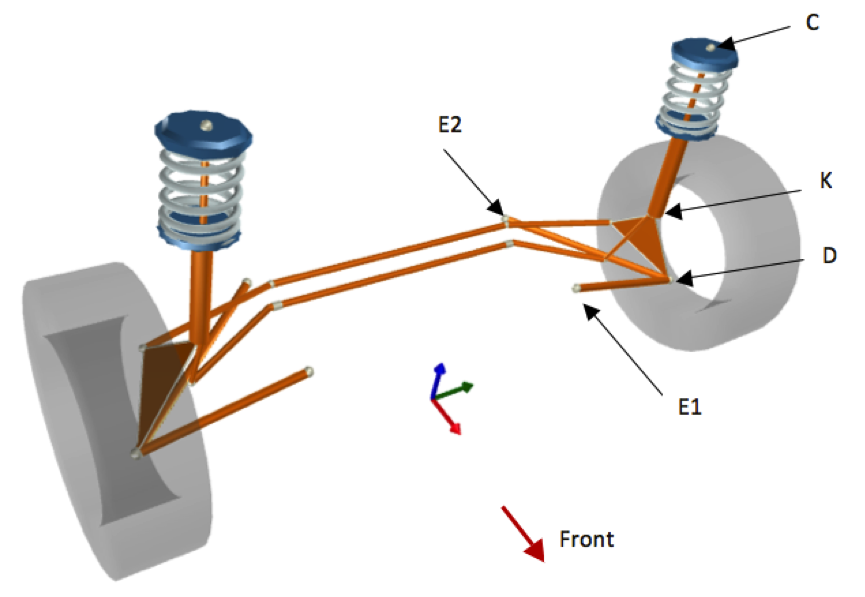
The convention used in this article is the SAE convention . However, other conventions are used by automotive manufacturers (ISO, ISO-W, …).
Wheelbase and track

Wheelbase is the distance between the front and rear tire contact patch. A long wheelbase promotes stability in straight line whereas a short wheelbase allows a better corner entry.
Halftrack is the horizontal difference from the center of the tire contact patch to the longitudinal axis. Therefore, the track is the distance between right and left tire contact patch.
Effect on vehicle behavior
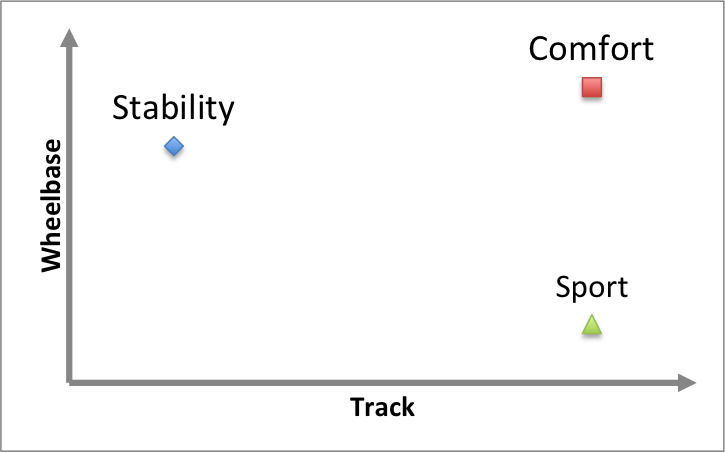
Toe angle and camber angle (or inclination angle)
Toe is defined as the angular deflection from the vehicles centerline and the centerline of the rim. Positive toe (toe out) is defined as a wheel splaying out from the direction of travel. Toe Angle carries the same sign as Toe Distance.
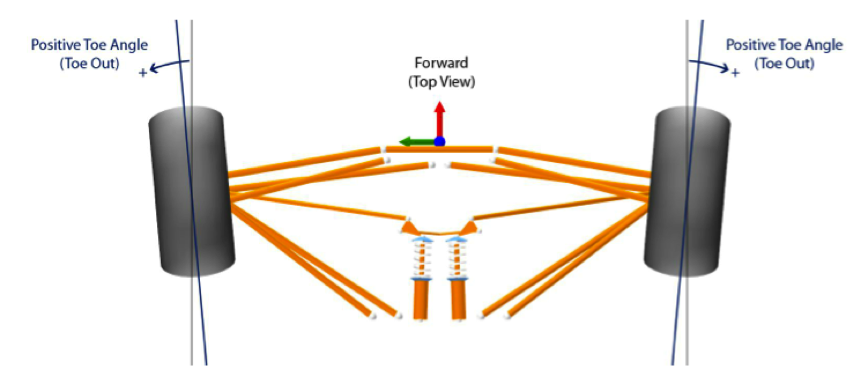
Camber is defined as the inclination angle between the side plane (vertical-longitudinal plane) and the rim plane lying on the centerline of the rim. Positive camber is defined as the tops of the wheels tipping away from the vehicle.
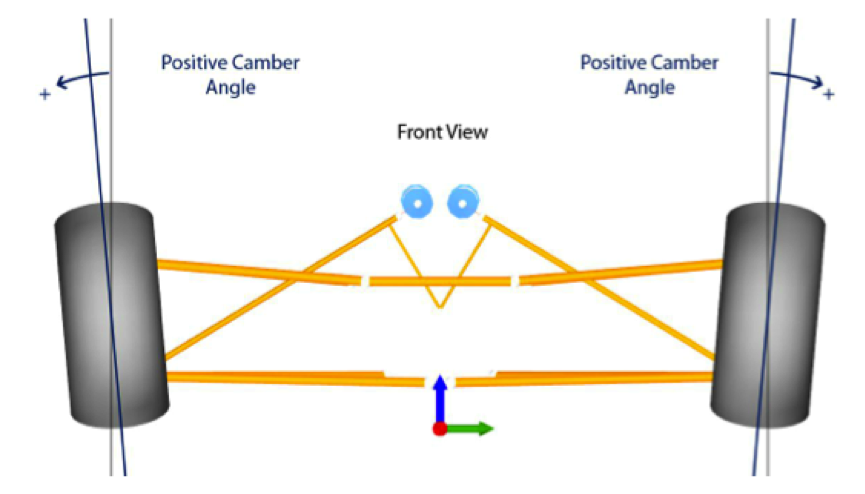
Camber plays an important role on lateral forces provided by the tire. Static camber angle can compensate camber gain on the outside wheel when the vehicle is rolling. The graph below shows the lateral force as a function of tire slip angle for different camber angles.
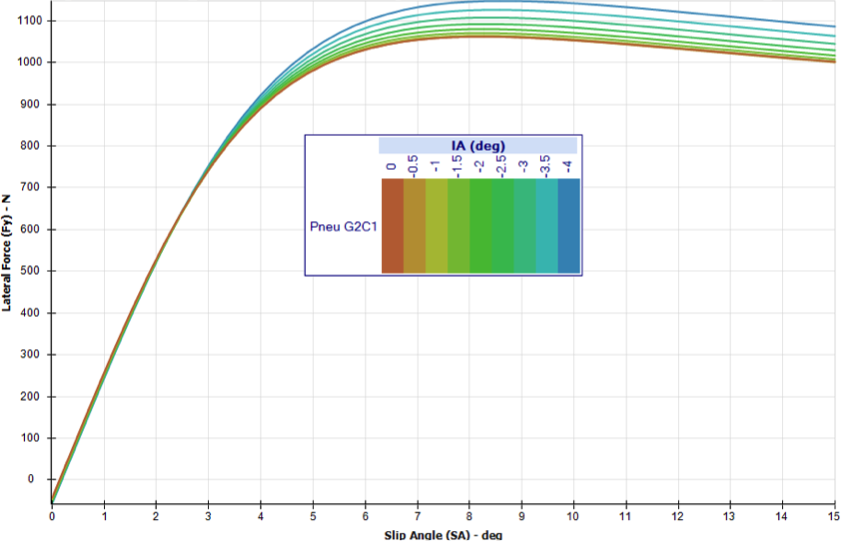
As it can be sees, the bigger the negative camber is, the greater the tire lateral force is, until a certain limit.
The camber variation is also important when designing the king pin angle and caster angle. In fact, these two values affect the camber gain when steering.Suspensions may have toe angle and camber angle in their static positions. These static angles play a very important role in the vehicle behavior and tire wear. Traditionally, automotive manufacturers adopt a negative toe angle (toe in) on the rear suspension to stabilize the rear of the vehicle and promote understeer, with a negative camber angle in order to decrease tire wear. On the front suspension, a positive toe angle allows better vehicle stability in braking and cornering (understeer behavior).
King pin angle and scrub radius
King pin angle is defined as the angle between the steering axis (CD axis in the figure at the beginning of this article) and an axis extending perpendicular from the contact patch, viewed front on (perpendicular to the vertical-lateral plane.)
Positive king pin angle is defined as the top of the steering axis being closer to the vehicle centerline.
Scrub Radius is defined as the distance between the intersection of the steering access and the ground measured to the center of the contact patch, viewed perpendicular to the vertical- lateral plane.
Positive scrub radius is defined as the steering axis intersecting the ground plane between the vehicle centerline and the contact patch.
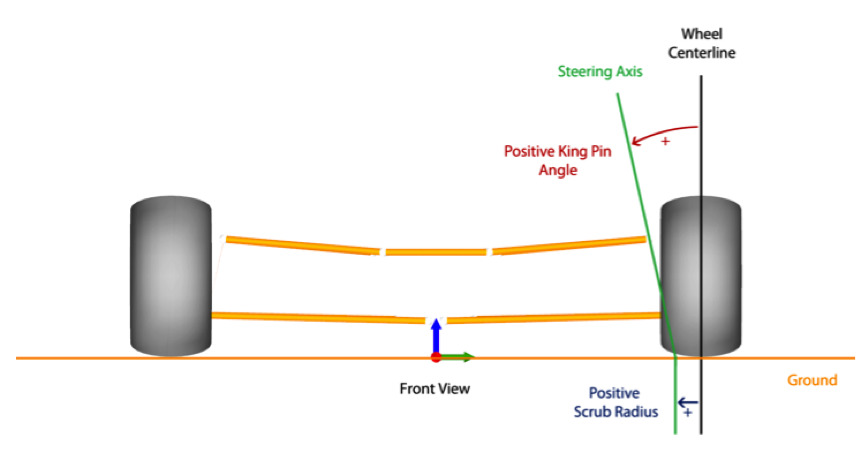
Influence on the vehicle behavior
The king pin angle has an influence on the geometric variations of the wheel plan when steering and the forces transmitted to the chassis. Combined with the caster angle, it affects the steering stability. The king pin angle must be positive to allow a better steering feedback but should not be too high to limit the camber gain when steering. In fact, when a steering wheel angle is applied it induces a negative camber gain on the outer wheel and a positive camber gain on the inside wheel.
The scrub radius is the “lever arm” of longitudinal forces applied at the contact patch (when braking). On the front suspension, a positive scrub radius gives stability because it causes toe out when braking and toe in when accelerating. A negative scrub radius is suitable for vehicles with high power engine and a positive scrub radius offset for small power engines.
Caster angle and mechanical trail
Caster is defined as the angle between the steering axis and the wheel centerline extending perpendicular from the contact patch, viewed perpendicular to the side view (vertical longitudinal plane).
Positive caster is defined as the steering axis tilting back from the wheel centerline in side view (perpendicular to the longitudinal-vertical axis).
Mechanical Trail is defined as the distance between the intersection of the steering access and the ground measured to the center of the contact patch, viewed perpendicular to the vertical longitudinal plane.
Positive mechanical trail is defined as the steering axis intersecting the ground plane before the contact patch.
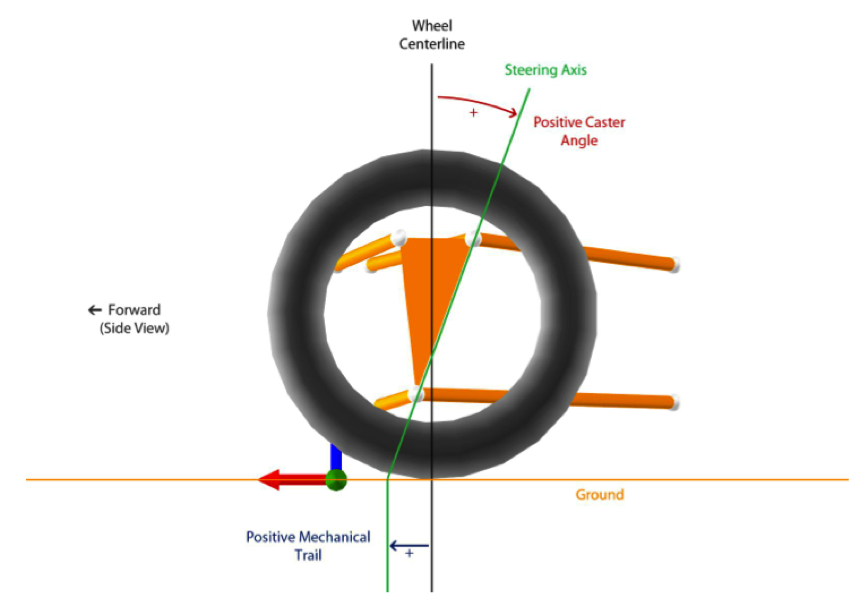
Influence on the behavior:
A positive caster angle produces a self-centering action of steering , and gives a steering feedback for the driver in straight line. This makes a vehicle easier to drive with a better steering response and directional stability. It also causes a camber gain (less negative camber) when steering on the outer wheel and thus improves vehicle behavior in cornering. Due to this caster angle, a power steering is usually used by manufacturers.
With a positive mechanical trail, the wheel is “pulled” by the vehicle as a wheel of a shopping trolley. Thus, it produces a self-righting effect in straight line which affects the vehicle’s straight-line stability.
This induces forces in the steering and makes the vehicle sensitive to lateral forces. A negative mechanical trail will increase the tendency to wander.
Kingpin offset
The king pin offset is defined as the distance between the center of the wheel and the crossing point of the king pin axis and the wheel spindle axis.
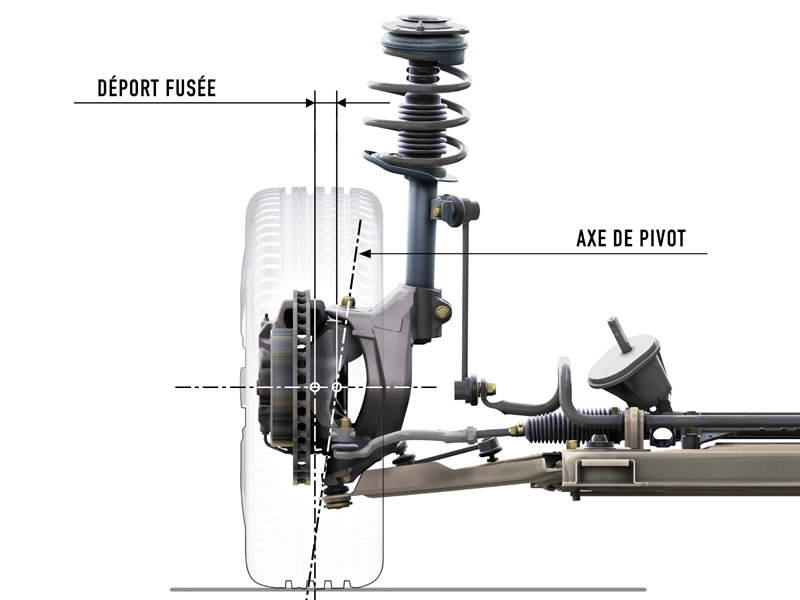
Déport fusée = Kingpin offset, axe de pivot = kingping axis
The kingpin offset is the “lever arm” of the longitudinal forces at the wheel center. It produces a self-centering action of steering, mainly sensitive at low speed. At high speed, it is usually minimal compared to other effects such as the caster angle effect.
There are several parameters that affect the behavior of the vehicle, providing a multitude of possible settings with as usual a lot of trade-offs. Manufacturers try to find the optimal suspension (double wishbones, Mac-pherson, multi-links…) and the right setting depending on the behavior they want to give to the vehicle (comfort, sport…).
Related Posts

The Mitsubishi Innovative Valve timing Electronic Control system (MIVEC) engine

Torque overlay technology

The Mitsubishi 4-Wheel Drive System

OptimumKinematics: suspension design and analysis software

Introduction to adaptative frontlighting system
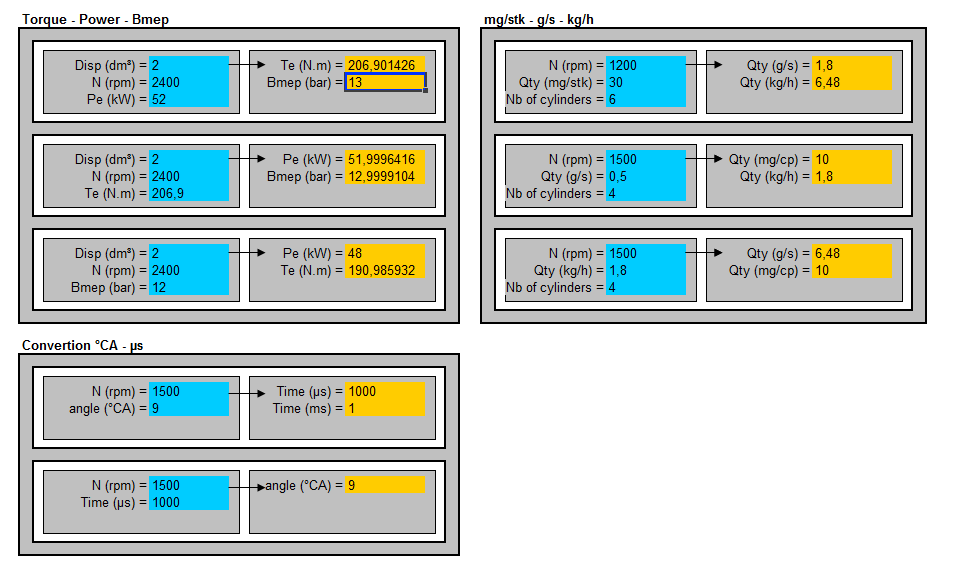
Engine units conversion tool

Cordierite for catalytic converters

Toyota Collision Avoidance Assist System

Being a powertrain simulation engineer
Trw adaptative side airbags.

The Microfit and GPSfit systems from Faurecia

Dana Launches Spicer™ iPad Application for Aftermarket Customers

Ricardo optimizes future battery pack technology

Innovative detector of neutral gear position

Glossary Combustion

The IFP School Powertrain Engineering MSc

Euro NCAP ratings explained

The moose test (or VDA test)

Introduction to manual transmission technologies

ESP: Electronic Stability Program
16 thoughts on “suspension design: definitions and effects on vehicle behavior”.
I’m a little suspicious of some of the caster angles listed as examples. 30 and 38 degree values seem unreasonably high.
Hi Darrell,
Thank you for your comment. There was a mistake in the table title, the values presented were examples of Mechanical Trail and not caster angle. I updated the article. Thanks again for the feedback.
AWESOME ARTICLE!
Sir in u r complen any jobs
Interesting ! Some pictures are no more redeable. However, the camber angle effect shown in the picture is not accurate : if the effect of camber angle on the ultimate side force is correct, the linear effect is forgotten : at zero side slip angle, the camber generates a linear side force in the direction of the camber. Thi is well known and, for instance, very sensitive driving in straight line with an important negative camber.
Tu artículo es fabuloso, me ha ayudado muchíiiiisimo en una traducción que tengo que hacer- Podrías enviármelo por el e-mail???? 1000 gracias
lot of stuff that can be useful
The majority of sources I’ve checked show toe-in as positive and toe-out as negative – the opposite of your diagrams. Just a FYi
Hello, It is a matter of naming convention. For example, with ISO-W standard, it will be positive on the right and negative on the left for the toe angle. Some companies use as you described some others don’t.
That could get REALLY confusing. Keep it the same: Toe in on any wheel is POSITIVE and Toe out on any wheel is NEGATIVE.
Does spring stiffness and damper coefficients have effects on spring design? Im doing suspension analysis and what result should i obtained from the analysis? Help me. Thank you.
TOE IN is POSITIVE, you said it was negative!
quote : “Traditionally, automotive manufacturers adopt a negative toe angle (toe in)”
Mechanical Trail and Tyre Inflation Pressure. A Theory:
When the pressure in a tyre is reduced the contact patch is enlarged. The total dynamics of the rolling tyre start where the “rubber hits the road”. As such one half of the increase in the contact patch length is added to the mechanical trail there by increasing the straight line stability in the same manner as increasing the caster angle.
Information on how some cars have different values of these variables for their particular purpose is very good to know . But How did they approach to these numbers? i.e what kind of parameters did they take to calculate these variables. How could i implement caster , camber, toe and SA to a requirement of a vehicle?
Pingback: Tire Alignment - Acom Trading
You need to realise that toe in/toe out is to counter the effects of the road wheel transcribing a conical rolling pattern relative to it’s camber setting. Therefore negative camber requires that there be toe out, positive camber requires toe in. I appreciate that toe in/toe out gets “fiddled” with in an attempt to achieve other traits (mostly to cover up other poor handling qualities)
Leave a Comment Cancel Reply
Your email address will not be published. Required fields are marked *
This site uses Akismet to reduce spam. Learn how your comment data is processed .
You are using an outdated browser. Please upgrade your browser to improve your experience.

- Product Lines
- Shoxs Suspension Seats
- Kinetix Impact Monitoring
- Accessories
- Military / Professional
- Recreational
- Seat Selection
- Custom Engineering
- Human Factors
- Performance Testing
- Whole Body Vibration
- About Shoxs
- Impact Science
- United Safety & Survivability Corporation 101 Gordon Drive Exton, PA 19341, United States
- 610-265-3610
- [email protected]
You have no items in your cart, add some on the products page .
- Find a Dealer
- 2024 Catalog
Suspension Travel
Shock size matters, more suspension travel results in a smoother ride.
Imagine a car speeding towards a brick wall. The average force (and acceleration) required to bring a moving body to rest is inversely proportional to the stopping distance. The ability of a shock-mitigating device to lessen an impact and ensure a smooth ride is tied to its stopping distance. It’s the equivalent of gently applying the brakes on the car, allowing it to roll to a halt over some distance.
Acceleration: Defined
We gain further insight by considering the definition of acceleration: the rate of change of velocity with respect to time. When a boat collides with a wave it undergoes a velocity change due to its motion relative to the water’s surface, and so the acceleration will depend on the size of that change and inversely depend on the time over which it occurs. This suggests the two main approaches to lowering impact severity: reduce the impact velocity or increase the time duration of the event.
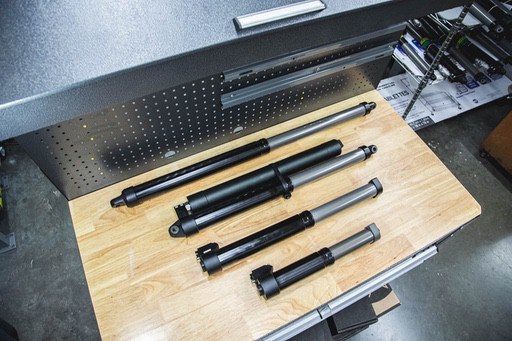
Impact Factors on the Water
On the water, a boat’s hull design, speed, and the sea-state are the dominant factors that dictate the velocity change during a wave slam. This change is thus reduced by improved hull design, slowing down, and avoiding poor conditions. These preventative measures lie at the heart of any shock-reduction strategy, but impacts cannot be eliminated entirely. In certain cases, speed cannot be reduced, waves cannot be avoided, and even the most experienced operator can be caught off-guard.
Milder Rides
Shock mitigating equipment is designed to increase the time duration of each impact. The longer it takes to undergo the impact velocity change, the smoother the ride will be, and adding suspension travel to a shock-mitigating device is a sensible way to achieve this. It’s akin to giving the imaginary car more braking distance before the wall.
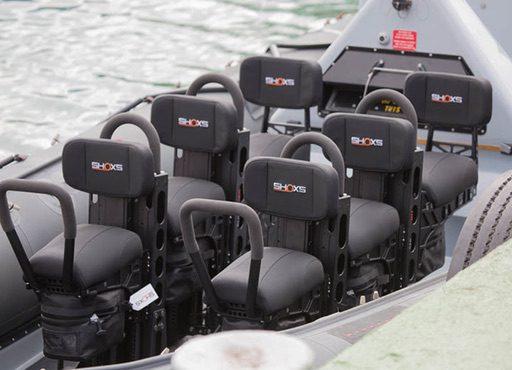
Comparing Suspension Travel Lengths
A longer deceleration leads to lower average forces. This explains why a 1” platform of vibration-mitigating foam is inferior to a 4” travel suspension system when it comes to mitigating shocks. Likewise, a 4” travel suspension will be outperformed by its 10” counterpart. The principle applies to impacts in any direction, including lateral. If only a short suspension travel distance is provided, a proportionate level of shock-mitigation can be expected.
Other Considerations
Of course, there are space and weight limitations on any boat, and ergonomics must be a top priority. Operators must interact with controls, maintain a low profile, and avoid sacrificing their sightlines. But when it comes to shock-mitigation, bigger really is better, and long-travel suspensions will yield the best results.
- 903-993-0000
- [email protected]
Glossary of suspension terms
Need help with your suspension terminology? We understand suspension can be complex and somewhat daunting at first. We created an in-depth list of suspension system terms and definitions to help.
Anti-dive is a suspension characteristic that affects the amount of suspension travel when the brakes are applied. When a car is decelerating due to braking there is a load transfer off the rear wheels and onto the front wheels. Vehicle properties such as the center of gravity height, total weight, deceleration rate and wheelbase affect the amount of dive a vehicle experiences. 100% anti-dive refers to no change in front suspension height under braking. This is achieved by adjusting the pivot points of the suspension system or through hydraulics in the front dampers.
Rear suspension kinematic characteristic which reduces the amount of pitch under braking forces. Street cars may have up to 150% anti-lift for driver comfort.
Anti-Roll Bar (aka: stabilizer bar, sway bar - from anti-sway bar)
A transverse torsion bar linking both sides of a suspension system with bushings mounted on the chassis that allow it to rotate freely. The bar's ends are connected to or shaped as lever arms, with attachments to the suspension linkages at each side via ball-joint links, rubber-bushed pivot links, or as on race cars, spherical rod ends called Heim joints. When both wheels take a bump equally, the wheels move the same amount without twisting the anti-roll bar. Individual wheel movement or body roll will force the bar to twist as the lever arms are moved, thereby adding the bar's own spring rate to that of the car's springs. Although an anti-roll bar's main function is to reduce body roll in cornering, it also influences overall handling. You can fine-tune Over- or Understeering Tendencies.
When a car is accelerating forward, there is a load transfer off the front wheels and onto the rear wheels. Vehicle properties such as the center of gravity height, total weight, acceleration rate and wheelbase affect the amount of squat a vehicle experiences. 100% anti-squat refers to no change in rear suspension height under acceleration. This is achieved by adjusting the pivot points of the suspension system or through hydraulics in the rear dampers.
The geometric center and innermost point of a turn or corner on a roadway or race course.
Description of handling characteristics of a vehicle, describing understeer, neutral, or oversteer.
Weight added to a vehicle usually to bring it to a minimum weight requirement-useful for adjusting balance in racing vehicles.
Torsional stiffness of the antiroll bar (or torsion bar), either at the drop links or at the wheel's contact patch. This is usually expressed in N/mm or lb/in.
Linkage component with a central pivot and multiple link attachment points. Usually used with inboard suspensions to transfer loads from the pull/push rod to the spring/damper. Technically, a rocker uses the same pivot for pullrod and damper, while a bell crank has different attachments for each.
Vertical movement of wheel towards chassis. Aka deflection, jounce. In racing, the terms "bump and droop" are used together to define suspension travel. For OEM" jounce and rebound".
Change in toe angle under bump/droop. Normally, slight toe-in with bump is used in the rear and slight toe-out with bump is used in the front to aid stability. Excessive bump steer in the front can be caused from incorrect angle of the steering tie-rods from excessive lowering.
The wheel angle relative to ground/chassis in front/rear view. Negative camber is when the tops of the wheels are closer together than the bottoms. Tuning the amount of negative camber can be very useful in achieving maximum grip in racing. Excessive negative camber can wear the inside edge of the tires under acceleration or braking and reduces grip. Not enough negative camber can wear the outside edge of the tire while cornering and reduces grip.
The caster angle identifies the forward or backward slope of a line drawn through the upper and lower steering pivot points when viewed directly from the side of the vehicle. Caster is positive if the line angles towards the rear of the vehicle at the top, negative if the line angles towards the front. Positive caster improves directional stability.
Center of Gravity (CoG)
The exact point around which an object, such as a vehicle, is perfectly balanced in every direction. It's the center point of the vehicles mass. The position of the center of gravity affects stability and handling: lower is usually more stable.
Centrifugal Force
The apparent force that draws a rotating body away from the center of rotation. Centrifugal force is not a true force; it is a form of inertia.
Chapman Strut
Named after Colin Chapman of Lotus Racing. It is basically a MacPherson type strut used in a rear suspension.
A term used to describe a type of spring.
When a spring is compressed to a point that the coils make contact. The spring has travelled to its maximum compressed height or at full block.
Coilover is short for "coil spring over shock". Consists of a shock absorber with a coil spring assembled together as one unit. Most coilovers have adjustable ride height using an adjustable spring perch.
Coil Spring
It's actually a torsion bar, wound into a helical shape. It's the Heart of the Suspension System carrying the car's weight under all static and dynamic conditions, absorbing the shocks from uneven roads and bumps, and correctly positioning all other suspension components. But it can provide only partial roll resistance as the Anti-Roll Bars provide additional support.
Compression
The displacement of sprung and unsprung masses in the suspension system in which the distance between the masses decreases from that at static condition. Compression damping is the primary factor in ride quality, road compliance and steering response.
Control Arm (aka: A-arm)
A hinged suspension link between the chassis and strut or wheel hub. A Double A-Arm suspension has upper and lower control arms. A control arm may also attach to a spring, damper, anti-roll bar and pull/push rod.
The ability of a vehicle to travel through a curved track or highway. Cornering force (side force) is the lateral force that will push the vehicle toward the outside of the corner while cornering.
Corner balancing (aka: corner weighting)
Optimizing the weight of the vehicle at each wheel to maximize the vehicles transitional response. Tire traction and suspension movements are determined by the force (weight) on each corner of the vehicle. Equal diagonal weighting provides the best transitional response while equal front weight provides the best braking response. Adjustable ride height coilovers allow easy fine tuning for maximum and balanced cornering performance without adding ballast.
Damper (aka: shock absorber)
A shock/strut used to dampen the kinetic energy of a spring and control rate of load transfer. All hydraulic dampers (shock absorbers) work by the principle of converting movement into thermal energy (heat). For that purpose, fluid in the damper is forced to flow through restricted holes and valve systems, thus generating hydraulic resistance. See also shock absorber.
Digressive damping
Digressive damping describes a style of damper valving. Digressive means that as damper shaft speed increases, damping forces increase at a decreasing rate. In comparison, a linear rate damper follows the same increasing path. This allows for sport dampers to offer more low speed control for performance handling without being overly harsh on rough roads or big bumps.
Dive (aka nose-dive)
Vehicle pitch under braking.
Double A-Arm
Independent suspension design with a short upper and long lower arm connecting chassis to suspension upright. Each arm is in the form of an A or V when viewed from above. Very common in racing; allows precise control of camber and roll center.
Double Wishbone
(aka: double a-arm)
Downforce (aka negative lift)
Downwards thrust created by the cars aerodynamics, typically through wings and spoilers. Additional downforce allows a car to corner faster by increasing the vertical force on the tires, which creates more grip.
Rebound (aka: droop)
Amount of down travel of a suspension system. In racing, the terms 'bump and droop" are used together to define suspension travel; automotive engineers call it "jounce and rebound".
Attach anti-roll bar to suspension arms, upright or strut. The name comes from the typical configuration: a link drops down from the anti-roll bar to the lower suspension arm.
Dynamic Weight Distribution
Weight distribution while driving under transient handling or aerodynamic forces.
Full Coil Suspension
A vehicle suspension system in which all four wheels have their own coil spring.
Gas-filled Shock Absorber (aka: gas shock or damper)
A shock that uses nitrogen gas, to pressurize the fluid in the shock to reduce or prevent aeration or foaming which can cause cavitation and loss of damping.
The amount of adhesion (traction)a tire has to the road.
Heavy-Duty Shock Absorber
Shock absorbers having reinforced seals, a mono-tube design to reduce heat build-up, and a rising rate valve for precise spring control.
Helper Spring
A very soft spring used in racing to prevent the Main Spring (or Main- and Tender Spring) from becoming loose in the spring seats, when the suspension is unloaded or at full droop.
Suspension spring system where the spring/damper is mounted near or within the chassis via rocker and pull/push rod system. Principal advantage is removing the spring/damper from the airstream, improving drag and downforce on ground effects cars (motorsport). Brake system where the disk and caliper are mounted on the sprung mass, via axles and CV joints. Principal advantage is reducing unsprung mass. (motorsport)
Independent Suspension
Any suspension which is not a solid axle type. This allows each wheel to move vertically (reacting to bumps or road irregularities) independently form each other.
Instant Center
The wheel and tire motion is constrained by the suspension links on the vehicle, the motion of the wheel package in the front view will scribe an imaginary arc with an "instantaneous center" of rotation at any given point along its path. The instant center for any wheel package can be found by following imaginary lines drawn through the suspension links to their intersection point.
Vertical force applied on chassis under cornering. This force can lift the vehicle if the roll center is above ground or drop if underground. Susceptible with swing axle suspension design. Typically, jacking will cause a slight increase in ride height and slight loss of camber while cornering, which results in loss of grip.
Jacking Down
Temporary lowering of chassis on bumpy roads due to excessive rebound damping.
Jounce (aka bump)
The upward travel or compression of the spring and shock absorber.
Describes the motion characteristics of a suspension, as opposed to the force characteristics (motion ratios).
Kinetic Energy
The energy an object possesses due to motion.
Opposite of downforce.
To raise a vehicles ride height for additional ground clearance to increase off-road capability.
Linear-rate coil spring
A coil spring with equal spacing between the coils, one basic shape, and constant wire diameter having a constant deflection rate regardless of load.
Aka oversteer (motorsport, NASCAR).
Lowering (aka suspension lowering)
Lowering the vehicles CoG. The main goal in lowering a vehicles CoG with the suspension is to improve handling and stability (street performance and motorsport). As always there is a right way and a wrong way to lower a vehicle.
Yes/Right way: With a properly engineered lowering suspension kit, the components fit perfectly into the factory locations and maintain proper fitment from full droop to full jounce. The lower CoG benefits are many, both in performance and appearance:
Performance: reduced nose dive under braking, squat while accelerating and body roll when cornering. Also, with the reduced ride height there is another benefit that is often overlooked: better aerodynamics. Since less air goes underneath the vehicle (where most aerodynamic drag occurs) it requires less horsepower to move the vehicle forward. The results, better fuel efficiency and higher top speeds (motorsport). Appearance: The lower CoG and corresponding ride height reduces excessive fender-well clearance giving the vehicle a more aggressive stance: Traction + Attraction! No/Wrong way: Improper lowering (short springs, cut springs, heating springs) can be very dangerous; too low results in improper suspension arm angles causing severe bump steer, improper wheel alignment and the suspension and/or chassis bottoming out, which can all contribute to a complete loss of handling and control. Short or shortened springs can fall out of their spring seats at full droop, which can cause a severe accident. Heating the spring causes the spring to lose tensile strength and will cause the spring to fail and collapse very quickly. Lowering the wrong way can lead to catastrophic results and a much bigger expense in repairs to get it corrected.
MacPherson Strut
Type of car suspension system which uses the top of a telescopic damper as the upper steering pivot. It is widely used in the front suspension of modern vehicles and is named for Earle S. MacPherson, who developed the design.
Inboard suspension system which is actuated by both left and right wheels to a single spring/damper. All roll resistance is then carried by the antiroll bar. (motorsport - Formula series).
Motion Ratio
The difference of motion on a vehicles suspension spring and shock travel for a given amount of wheel travel. If the spring is half the distance from the control arm pivot as the wheel, the motion ratio relative to the wheel is 1 to 2.
Multilink Suspension
Common on independent suspension systems, using three or more lateral arms instead of only one upper and lower control arm per corner.
Handling characteristic between understeer and oversteer. This is usually the goal of chassis tuning, with a slight bias towards over or under-steer depending on track conditions and driver preference (motorsport).
Lateral distance between a wheel's vertical centerline and hub face. Positive offset has wheel center line further outboard than hub face; generally found on front wheel drive vehicles and newer rear wheel drive vehicles. Improper offset can negatively affect the handling of a vehicle.
Outboard Suspension
Traditional suspension system where the spring/damper is mounted directly between the chassis and lower/upper arm or upright.
The lengths of a vehicle, either front and rear, which extend beyond the wheelbase.
Vehicle handling characteristic that occurs when a car turns (steers) by more than (over) the amount commanded by the driver. Therefore, the rear wheels tend to lose traction before the front.
Percent Slip
Amount of longitudinal (accel. & braking) slip between the tire and the road. This is expressed as the ratio of the velocity of slipping to the CL wheel velocity. As with slip angle, there is an optimum percent slip for maximum grip, beyond which the tire spins. (Motorsports).
Viewed from the side, the change in vehicle angle with respect to the ground. For example, in braking, weight is transferred from the rear to the front, causing unloading of rear springs and additional load on the front springs, resulting in nose dive. The effect may be reduced or eliminated with anti-pitch suspension geometry, lower CoG, longer wheelbase or higher spring rates.
Polar Moment of Inertia
The resistance of an object to rotational acceleration. When the mass of an object is distributed far from its axis of rotation, the object is said to have a high polar moment of inertia. When the mass distribution is close to the axis of rotation, it has a low polar moment of inertia. A mid-engine car has most of its mass within its wheelbase, contributing to a low polar moment of inertia, which, in turn, improves cornering turn-in.
Pre-Setting (aka Blocking)
A complex production technology. Most suspension springs go through the Pre-Setting process. Designed to expand the stress levels to higher limits each spring is compressed to full block, meaning all coils make contact under pressure. This allows new engineering limits to design superior products and to make springs permanently block-resistantÑno more sagging! All product design characteristics will now be maintained for the life of the spring, unless damaged; physically or by corrosion.
Progressive-rate spring
A spring system that increases in spring rate with increase in deflection/travel.
Inboard suspension component which place the spring/damper unit inboard and out of the air stream to further reduce air resistance. The pull rod typically attaches near the upper ball joint and pulls on the inboard rocker when in bump. Pull-rod designs often have somewhat lower and more non-linear motion ratios due to packaging of the rocker next to the ground, which allowed the designers to put more components close to the car's floor, lowering its center of gravity. (Motorsport)
Aka understeer (motorsport & NASCAR).
Inboard suspension component which place the spring/damper unit inboard and out of the air stream to further reduce air resistance. The push rod typically attaches near the lower ball joint and pushes on the inboard rocker when in bump. Push-rods may be preferred to pull-rods for more adjustability with higher and more linear motion ratios, however may introduce buckling concerns. (Motorsport)
The wheel and suspension go back down away from the chassis. The main function of rebound in a damper (shock absorber) is to control the speed by which the suspension travels during reboundÑcontrolling the spring rate on the car. Rebound damping also provides the roll control of the vehicle.
Rising Rate
A suspension system where the spring rate increases when the wheels move further into jounce. This action can be accomplished by configuring the geometric shape of the suspension, by using progressive rate springs which change tension as they are compressed, or by using two or more springs with rubber stops. The purpose of a rising-rate suspension is to maintain consistent ride and handling characteristics under a variety of situations: loaded or unloaded, straight roads or curves, and smooth roads or bumpy.
Road Holding
The ability of a vehicle to maintain contact with the road surface under all conditions. The constant contact of the tires to the ground is crucial for the vehicle to steer, brake and accelerate.
Road Isolation
The vehicle's ability to absorb shocks from irregular road surfaces and keep them from the passenger compartment.
Inboard suspension component used to transfer wheel loads to the spring. The rocker may be either an entire suspension control arm (usually the upper arm) or a component between the pull/push rod and spring.
A line that connects the front and rear roll centers. If the axis runs nose-down, the car tends to oversteer. If the axis runs nose-up, the car tends to understeer.
Roll Center
The theoretical point around which the chassis rolls, and is determined by the design of the suspension. Front and rear suspensions have different roll centers. The amount that a chassis rolls in a corner depends on the position of the roll axis relative to the car's center-of-gravity (CoG). The closer the roll axis is to the center of gravity, the less the chassis will roll in a corner.
Roll Couple Distribution (RCD)
The ratio of weight transfer of the front and rear wheels, usually expressed as a percentage. The roll couple percentage is a simplified method of describing lateral load transfer distribution front to rear, and subsequently handling balance. It is the effective wheel rate, in roll, of each axle of the vehicle as a ratio of the vehicle's total roll rate. It is commonly adjusted through the use of anti-roll bars, but can also be changed through the use of different spring rates.
Roll Flexibility
Expressed as degrees of chassis roll per G of lateral acceleration. Street cars range between 2.5' and 6'. Most race cars 0.3' - 0.8' (ground effects cars essentially do not roll -- below 0.1' is common). Excessive roll stiffness degrades handling on bumpy circuits. Insufficient roll stiffness reduces transient response and tire grip.
Roll Moment
The roll moment is the product of the sprung mass and the square of the distance between the vehicle's roll center and its center of mass. If the vehicle is subjected to centrifugal forces, such as in a turn, the roll moment will cause the body to rotate (lean) towards the outside of the turn. Together with the roll stiffness, this factor determines the roll flexibility.
Roll rate is similar to a vehicle's ride rate, but for actions that include lateral accelerations, causing a vehicle's sprung mass to roll about its roll axis. It is expressed as torque per degree of roll of the vehicle sprung mass. It is influenced by factors including but not limited to vehicle sprung mass, track width, CG height, spring and damper rates, roll center heights of front and rear, anti-roll bar stiffness and tire pressure/construction. The roll rate of a vehicle can, and usually does differ front to rear, which allows for the tuning ability of a vehicle for transient and steady state handling. The roll rate of a vehicle does not change the total amount of weight transfer on the vehicle, but shifts the speed at which and percentage of weight transferred on a particular axle to another axle through the vehicle chassis. Generally, the higher the roll rate on an axle of a vehicle, the faster and higher percentage the weight transfer on that axle.
Roll Stiffness
The resistance to chassis roll from the springs, anti-roll bars or both. Together with the roll moment, the total roll stiffness of the vehicle affects the roll flexibility.
Lateral displacement of the wheel centerline in bump/droop due to an instant center above or below ground. Suspension design should keep scrub to a minimum to reduce unwanted side loads generated during a bump. Scrub is not the same as "scrub radius".
Scrub Radius
The distance in front view between the steering axis and the center of the contact patch of the wheel, where both would theoretically touch the road. If these lines intersect at the road surface, a zero scrub radius would be present. When the intersection is below the surface of the road, this is positive scrub radius. Conversely, when the lines intersect above the road, negative scrub radius is present. The point where the steering axis line contacts the road is the fulcrum pivot point on which the tire is turned. Scrub radius is changed whenever there is a change in wheel offset as on the tyre line where the wheels are pushed outboard causing scrub radius to become more (+). Older cars tended to have very close to zero scrub radius but often on the (+) side, newer cars with ABS all have negative scrub radius (that's why all the newer cars have the wheels offset more inboard).
Section Height
The sidewall distance from the wheel rim to the unloaded tread surface. A low section height improves transient response; a high section height improves ride quality.
Section Width
Maximum width of an unloaded tire. Wider is normally better for grip, though excess width may result in insufficient tire temperatures and unnecessary unsprung weight.
Short-Long-Arm
Any independent suspension system with short upper arms and long lower arms (double a-arm, multi-link).
Single Wheel Bump Rate
Vertical wheel travel spring rate when only one wheel hits a bump. When this occurs the anti-roll bar does alter the spring rate. What happens is that the anti-roll bar twists as the wheel is raisedÑsince the other wheel does not move. The bar twists over its whole length adding this spring rate to the suspension spring rate.
A circular area of flat pavement used for various tests of a car's handling. The most common skidpad use is testing lateral acceleration, measured in g-force.
Referring to tiresÑthe indirect measure of the fraction of the contact patch that is sticking.
The angle between a rolling wheel's actual direction of travel and the direction towards which it is pointing. Tire grip increases with slip angle until a certain point, at which the tire starts to skid.
Suspension where left and right wheels are rigidly connected. They are nearly universally used in heavy-duty trucks and most light and medium duty pickup trucks, SUVs, and vans. Still used in motorsport: circle track, Trans Am and off-road.
A mechanical device, which is typically used to store energy due to resilience and subsequently release it, to absorb shock, or to maintain a force between contacting surfaces. They are made of an elastic material formed into the shape of which returns to its natural length when unloaded. Springs come in various forms: helical coil, torsion beam, leaf (semi-elliptical), rubber (polyurethane) bushing and air bag. The helical coil spring are most commonly used in street performance vehicles and motorsport. The other spring types are nearly universally used in heavy-duty trucks and most light and medium duty pickup trucks, SUVs, and vans.
Spring Rate
The spring rate (or suspension rate) is a component in setting the vehicle's ride height or its location in the suspension stroke. When a spring is compressed or stretched, the force it exerts is proportional to its change in length. The spring rate or spring constant of a spring is the change in the force it exerts, divided by the change in deflection of the spring. Vehicles which carry heavy loads will often have heavier springs to compensate for the additional weight that would otherwise collapse a vehicle to the bottom of its travel (stroke). Heavier springs are also used in performance applications where the loading conditions experienced are more extreme. Springs that are too hard or too soft cause the suspension to become ineffective because they fail to properly isolate the vehicle from the road. Vehicles that commonly experience suspension loads heavier than normal have heavy or hard springs with a spring rate close to the upper limit for that vehicle's weight. This allows the vehicle to perform properly under a heavy load when control is limited by the inertia of the load. Riding in an empty truck used for carrying loads can be uncomfortable for passengers because of its high spring rate relative to the weight of the vehicle. A race car would also be described as having heavy springs and would also be uncomfortably bumpy. However, even though we say they both have heavy springs, the actual spring rates for a 2,000 lb (910 kg) race car and a 10,000 lb (4,500 kg) truck are very different. A luxury car, taxi, or passenger bus would be described as having soft springs. Vehicles with worn out or damaged springs ride lower to the ground which reduces the overall amount of compression available to the suspension and increases the amount of body lean. Performance vehicles require different spring characteristic than average vehicles.
Spring Sag (aka: sagging)
The loss of spring load and length caused by a poor design, insufficient material or excessive loading beyond its physical limits. Over time, this can cause the spring to collapse or even break. There is a stress limit even for the best materials, but the max allowed stress levels are then superior. But even those high stress levels can be expanded by special production technologies - see Pre-Setting (aka: Blocking).

Sprung Mass
In a vehicle with a suspension, sprung mass (or sprung weight) is the portion of the vehicle's total mass that is supported above the suspension, including in most applications approximately half of the weight of the suspension itself. The sprung weight typically includes the body, frame, the internal components, passengers, and cargo.
Vehicle pitch under acceleration.
Stabilizer Bar
see anti-roll bar.
Static Weight Distribution
Static weight distribution is the weight resting on each tire contact patch with the car at rest, exactly the way it will be driven or raced (with driver Ð motorsport).
Steering Arm
Lever arm rigidly attached to upright or hub, which is connected to the tie rod. Steering arm and tie rod placement define the Ackerman steering system.
Static friction, usually referring to suspension, is friction that needs to be overcome to enable the motion of stationary objects. Higher stiction in a suspension, may lead to unpredictable chassis heights and poor handling.
The term given to the system of springs, shock absorbers and linkages that connects a vehicle to its wheels and allows relative motion between the two. Suspension systems serve a dual purpose & contributing to the vehicle's road holding/handling and braking for good active safety and driving pleasure, and keeping vehicle occupants comfortable and reasonably well isolated from road noise, bumps, and vibrations, etc. These goals are generally at odds, so the tuning of suspensions involves finding the right compromise. It is important for the suspension to keep the wheel in contact with the road surface as much as possible, because all the road or ground forces acting on the vehicle do so through the contact patches of the tires. The suspension also protects the vehicle itself and any cargo or luggage from damage and wear. The design of front and rear suspension of a car may be different.
See anti-roll bar.
Simple independent suspension of 1 lateral link rigidly connected to the wheel (early VW Beetle). With this design, wheel camber changes radically through the suspension stroke.
Tender Spring
Linear or progressive Tender Springs combined with Main springs provide a dual or multi-stage Suspension characteristic with a softer initial rate and a firmer final rate.
Tire Compound
A mix of materials that goes into making a tire. For performance and motorsport it's mainly about the hardness of rubber - softer is stickier, harder lasts longer.
The symmetric angle that each wheel makes with the longitudinal axis of the vehicle. Positive toe, or toe in, is the front of the wheel pointing in towards the centerline of the vehicle. Negative toe, or toe out, is the front of the wheel pointing away from the centerline of the vehicle. Toe can be measured in linear units, at the front of the tire, or as an angular deflection. Front wheels that toe-out slightly is preferred for turning response and toe-in for rear wheels adds stability.
Triangulation
In chassis design to prevent flex. Geometric configuration of chassis tube members. By adding a diagonal member, connected corners are held at a fixed distance. They can't be spread apart or moved closer together. Despite pivots for corners, the structure cannot be forced out of shape, and is therefore rigid. The additional member to a four-sided structure forms two triangles in the structure. This is called triangulation.
Suspension and chassis adjustments to optimize handling.
Understeer (aka: push)
Vehicle handling characteristic when a car steers less than (under) the amount commanded by the driver, meaning the front wheels tend to lose traction before the rear.
Unsprung Mass
The mass of the suspension, outboard brakes, wheels and other components directly connected to them, rather than supported by the suspension. The unsprung weight of a wheel controls a trade-off between a wheel's bump-following ability and its vibration isolation. Bumps and surface imperfections in the road cause tire compressionÑwhich induces a force on the unsprung weight. The unsprung weight then responds to this force with movement of its own. The amount of movement, for short bumps, is inversely proportional to the weight - a lighter wheel which readily moves in response to road bumps will have more grip and more constant grip when tracking over an imperfect road. In contrast, a heavier wheel which moves less will not absorb as much vibration; the irregularities of the road surface will transfer to the cabin through the geometry of the suspension and hence ride quality and road noise are deteriorated. For longer bumps that the wheels follow, greater unsprung mass causes more energy to be absorbed by the wheels and makes the ride worse.
Weight Distribution
See static weight distribution.
Wheel Frequency
Square root of (wheel rate/sprung mass carried by wheel). A characteristic of suspension stiffness that may be used to compare cars of different weights. Race cars typically have higher front frequencies than rear to reduce dive and improve traction; street cars are the opposite for "flat ride" over bumps.
Wheel rate is the effective spring rate when measured at the wheel. This is as opposed to simply measuring the spring rate alone. Wheel rate is usually equal to or considerably less than the spring rate since springs are mounted on control arms, swing arms or some other pivoting suspension member. Wheel rates are usually summed and compared with the sprung mass of a vehicle to create a "ride rate" and corresponding suspension natural frequency in ride (also referred to as "heave"). This can be useful in creating a metric for suspension stiffness and travel requirements for a vehicle.
The distance between the centers of the front and rear wheels. Longer wheelbase improves stability, shorter wheelbase improves maneuverability.
The angle between vehicle centerline and actual direction of motion around a turn. (oversteer/understeer).

Springrates, Trophy Tractor partner with Stefan Parsons for COTA
FOR IMMEDIATE RELEASE ABINGDON, VA (March 12, 2024):...

Brand Spotlight: Ohlins
In the dynamic world of aftermarket performance coilovers,...

Black Friday Coilover Suspension Sale 2023
🎉 Rev Up Your Ride with Our Black...

Save Up to $500 During Our KW Suspension End of Season Sale!
Save up to $500 back on eligible, KW...

Are Coilovers Ideal for Daily Driving? Exploring Performance and Practicality
Coilovers have become a popular suspension upgrade for...
Spend $250.00 more and get free shipping!
Too soon, Junior.
Order Comments:
ACCOUNT LOGIN
Enter your email and password to access your account.
RESET YOUR PASSWORD
We will send you an email to reset your password.
ACCOUNT REGISTER
Please fill in the information below to create your account.
Create account
Select a vehicle.
Select your vehicle below to see compatible products.
Reset vehicle
Is your vehicle not listed? Let us know.
- Choosing a selection results in a full page refresh.
What is suspension travel?
- Setting up VPP
- Getting started
- Creating vehicles
- Configuring vehicles
- 3D models and environment
- Extending VPP
- Component Guide
- Vehicle Controller
- Wheel Collider
- Ground Materials
- Camera Controller
- Vehicle Toolkit
- Vehicle Joint
- Differential
- Torque Splitter
- Other blocks
- Creating add-on components
- Creating custom vehicles
- Creating custom blocks
- VehicleBehaviour reference
- VehicleBase reference
- Block reference
- Data Bus reference
- Miscelaneous topics explained
- How suspensions work
- Configuring realistic vehicles
- Vehicle rigging notes
- Source Code vs. SDK
- How simple suspensions work
- Studying the oscillating behavior
- Suspension and simulation steps
- Application to real vehicles
How simple suspensions work #
A suspension is essentially a damped spring producing opposing force when being compressed. Springs sustain the weight of the vehicle. Dampers oppose the spring movement, dissipating their energy and preventing them to bounce without control.
The force produced by the springs depends on the distance they are compressed and it's given by Hooke's Law :
The force produced by the dampers depend on how fast the suspension is being compressed or elongated ( contact speed ), opposing the movement.
When a wheel is lifted from the ground the suspension produces no force. At the slightest contact possible it also won't produce any force. As the spring gets more compressed, more force is produced proportionally to the contact depth :
The compression limit is the suspension distance . Beyond this point the spring has reached its maximum force and cannot compress further. A hard contact with the rigid body is produced.
The suspension position is the contact depth where the spring force matches exactly the force applied on the spring. In vehicles this force is typically caused by the weight supported by the wheel:
- The more weight is loaded on a wheel, the more compressed will be its spring (suspension position visibly lower).
- The less weight is loaded on a wheel, the less compressed will be its spring (suspension position visibly higher).
- If the center of mass of a vehicle is moved (load, passengers...) the weight will be redistributed along the wheels and their suspensions will be compressed / elongated as result of the new weight distribution.
- If the vehicle is accelerating, braking or cornering the weight will be temporarily shifted among the wheels, varying their suspension positions accordingly. For instance, accelerating makes a certain amount of weight (depending on the actual acceleration) to be transfered from front wheels to rear wheels. Similar effects happen when braking and cornering.
- Aerodynamic surfaces push the vehicle down with speed, increasing the load on the wheels and compressing their suspensions accordingly.
The suspension force is calculated as:
When the suspension is not moving the contact speed is 0. This happens when the vehicle is either resting, cruising at constant speed or under constant acceleration. The suspension position for a specific wheel may then be calculated as:
Studying the oscillating behavior #
The suspension properties may be studied from the point of view of the oscillating behavior ( Harmonic oscillator ). The associated concepts are used to study the reactions of the suspension in different situations.
Understanding vehicle suspension as harmonic oscillator
A suspension behaves as harmonic oscillator under certain conditions , and may be studied as a harmonic oscillator under those conditions. Read Application to real vehicles below.
While a suspension based on specifying the oscillating properties (frequency, damping) is possible, simulating a suspension as a generic harmonic oscillator is generally a bad idea and may easily provide incoherent results. It's not just one, but four (or more) attached suspensions with complex interactions among them: weight shifting, cargo, aerodynamic downforce, road conditions...
Given the force produced by the suspension at a specific steady state ( contact speed = 0) the effective sprung mass value for studying that situation may be calculated as:
When the vehicle is at rest, cruising at constant speed or under constant acceleration on a flat surface the sum of the sprung masses of all the wheels matches the mass of the vehicle exactly.
Using the sprung mass you may calculate the natural frequency for the spring under those conditions. The natural frequency is the rate at which the spring can respond to changes in load:
The natural frequency defines the oscillating behavior of the suspension. For example, a typical family car is set up to exhibit a natural frequency somewhere between 5 and 10.
The effective sprung mass may also be used for studying the damping behavior , that is, the rate at which the suspension dissipates the energy stored at the spring. We may calculate the damping ratio for learning whether the suspension will be under-damped, over-damped or critically-damped:
A damping ratio greater than 1.0 means over-damping (sluggish suspension), a value of exactly 1.0 is critically-damped, and a value less than 1.0 is under-damped (bouncy suspension). Values for realistic vehicles are in the range of 0.2 and 0.6. The damper rate that targets a specific damping ratio may be calculated by rearranging the equation above:
Suspension and simulation steps #
Another interesting concept for the simulation is the number of simulating updates that will occur during each spring oscillation. This number is given by the alpha ratio:
Applying the Nyquist theorem we deduct that a physically correct simulation should have alpha >= 2. Smaller values means that the simulation sampling rate is not enough to simulate the given spring rate.
Application to real vehicles #
Suspensions in real vehicles don't have constant frequency and damping ratio at all times. You may calculate and study the oscillating behavior in specific situations separately: at rest, accelerating, braking... Weight transfer on some of these situations actually affects the behavior of the suspension. That's the challenge of configuring suspensions in real vehicles: finding a good balance for most situations.
If the vehicle is under constant acceleration (accelerating / braking / cornering) the weight is redistributed among the wheels. Wheels will be supporting more or less load than in their positions at rest. This effectively modifies the oscillating properties of the suspensions at those specific situations, therefore producing different reactions. For instance, imagine a racing car heavily braking at the end of a long straight before entering a slow curve. If that part of the track is a bumpy surface then the suspension must be set up properly for ensuring correct handling while braking over the bumps. Another example is the downforce caused by aerodynamic surfaces. Suspension will have different behavior on high speeds due to the additional load. Studying the oscillating behavior of the suspension in this detail is critical for setting up racing cars that react properly on every situation.
We may summarize the role of the vehicle suspension as:
- Springs sustain the weight of the vehicle.
- Dampers dissipate the energy in the springs when the suspension moves ( weight transfers , bumps).
When the suspension is not moving the dampers have no effect. This happens when the vehicle is at rest, cruising at constant speed, or under constant acceleration. Otherwise, weight transfers occur among the suspensions. The springs should be strong enough for sustaining the weight of the vehicle preventing the suspension to reach its limits on all situations, including weight transfers.
When the formulas for the Harmonic Oscillator (above) are applied to vehicles in those situations they yield a surprising result:
So the single factor that defines the frequency of our suspension is the contact depth . The frequency of the suspension will vary on the different situations (accelerating, braking, cornering...) according to the contact depth. Note that this contact depth includes any pre-load of the spring inside the suspension strut.
As a result, configuring the vehicle suspension for a similar behavior in a broad range of conditions requires minimizing the changes in the contact depth in those conditions. There are several strategies for this:
- Harder springs and anti-roll bars, reducing weight transfers on accelerating, braking, cornering, etc.
- A lower center of mass reduces the weight transfers without modifying the suspension properties.
- Electronically controlled suspension which dynamically modify the suspension properties to preserve the contact depth (and the ride height ) constant in all situations: accelerating, braking, cornering or carrying variable cargo or passengers.
Vehicle Physics Pro includes a variety of suspension components allowing different ways of configuring the suspension:
- VPWheelCollider component with standard spring and damper settings.
- VPAntiRollBar: links the suspension of the wheels in the same axle in order to control the lateral roll in curves.
- VPAdvancedDamper: configures dampers with bump / rebound parameters: slow bump, fast bump, slow rebound, fast rebound.
- VPDynamicSuspension: modifies the suspension spring in runtime order to preserve a given contact depth (or ride height ).
- VPProgressiveSuspension: Modifies the suspension properties along the suspension travel. This allows simulating bump stops or leaf spring suspensions .
From here you can search these documents. Enter your search terms below.
Keyboard Shortcuts
- Help Center
- Chat with a Ride Guide
- 1-866-401-9636
- Retail Store
- Bike Services
Reset Password
We will send you an email to reset your password.
Don't have an account? Create an account
Create Account
Already have an account? Sign In
- Favorite your products & save them to your account
- Save a search & get notified when new products drop
- Be first to know about the latest events & promotions
Bike Finder
Results have arrived, mtb travel - how much mtb suspension travel do you need what does it mean.
Do you want more suspension travel or less? How do you know how much you need? Here's how to decide whether a long-travel or short-travel MTB is better for you and your trails.
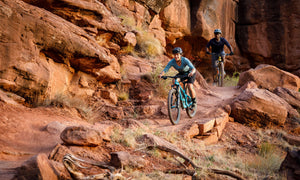
Written by: Bruce Lin
Published on: Mar 9, 2022
Posted in: MTB
You’re going to a big, important party, but you’re iffy about the dress code. Would you rather show up overdressed or underdressed?
A lot of mountain bikers face a similar dilemma, but instead of choosing the right clothes, it’s about choosing the right bike. You've probably heard certain bikes described as “too much bike” or “not enough bike.” But what does that mean?
In mountain biking, suspension travel often receives the most attention when riders are looking at bike specs. Depending on your skill, riding style, and terrain, there is likely an ideal amount of suspension travel. Other specs such as geometry , wheels , and tires matter too, but they are usually tailored to match a bike's suspension.
Most modern mountain bikes will have somewhere between 100mm and 170mm of suspension travel. This covers everything from cross-country race machines to versatile mid-travel trail bikes to hard-hitting enduro bikes . (If you want to learn more about how mountain bikes are categorized check out our Mountain Bike Buyer’s Guide .)
So what's the right amount of travel for you?
[button] SHOP MOUNTAIN BIKES [/button]
MTB travel basics: what is travel on a mountain bike?
In case you're new to riding, mountain bike suspension travel is a measurement of how much a wheel can move to absorb bumps. On the front, mountain bike travel comes from your suspension fork. At the rear, MTB travel is provided by some configuration of frame pivots that compress a rear shock.
When to choose a long-travel MTB

Long-travel bikes usually have 150-170mm of rear travel to handle tough downhill trails. Front travel often matches rear travel but sometimes can be more.
Trail and enduro bikes fall into this category. They absorb big hits and smooth out rough terrain. If you regularly ride steep or gnarly trails, a bike like this makes a lot of sense.
If you're mostly riding mellow flow trails though, a big and burly long-travel bike might be overkill. You won't be able to use all the suspension travel you paid for. The bike may feel cumbersome, maybe a bit boring, and you’ll have to expend more energy to push it around and climb uphill.
But let’s say you lack confidence on descents. A more capable enduro bike with ample suspension travel could help you enjoy riding more by increasing your confidence, comfort, and giving you more margin for error.
Some ride big and burly bikes everywhere because they're fit enough to pedal a long-travel bike up big climbs and on long rides without much trouble. For them, being overbiked isn't a handicap, and it's worth it for when the trail gets gnarly. If you care more about descending as fast as possible more than having a bike that's efficient for pedaling or climbing, long-travel bikes will cater more to your style.
[button] SHOP LONG-TRAVEL MOUNTAIN BIKES [/button]
When to choose a short-travel MTB

Short-travel bikes usually have 100-120mm of travel to maximize efficiency. In some cases, these bikes could have forks with 10-20mm more travel to make them more versatile on descents.
XC and short-travel trail bikes fall into this category. They are efficient and usually feel more agile than longer-travel bikes. If you race cross-country, do long adventure rides, or stick to mellow trails, these are the best option.
If you venture onto steep and gnarly downhill tracks with big rocks and jumps, a short-travel bike will start to feel sketchy. There’s a good chance you’ll have to ride slower and more cautiously than you would on a long-travel bike, taking easier lines and occasionally skipping tough sections.
But let’s say you dread going uphill and are constantly getting dropped by fitter riders. A bike with less travel that’s lighter and more efficient could help you go faster and expend less energy.
If you’re a skilled rider that just wants to make riding more exciting, short-travel bikes provide a lot more trail feedback and give you less room for error. You have to stay focused, be more selective about lines, and be more active with your body. For some, this can be a more enjoyable ride experience than just sitting back and letting a long-travel bike do the hard work for you.
[button] SHOP SHORT-TRAVEL MOUNTAIN BIKES [/button]
So how much suspension travel do I need?

Seth H., Merchandising Manager "I started on an XC hardtail and rode everything, even gnarly downhills on it. It had a dropper and I did just fine. I really thought it was all I would ever need. Then I went to Moab. I rode a borrowed enduro bike on The Whole Enchilada and it kind of opened my eyes. I bought a bigger bike not long after and started riding all my regular trails again. It changed how I rode.
"Personally, I really don’t mind being overbiked for most of my riding now. I ride alone a lot so I go my own pace. But I'm also decently fit and I can keep up with everyone I ride with on my bigger bike (an Ibis Ripmo). If you’re fit, I say go as big as you want."
Chad H., Warehouse Manager "I would prefer to be underbiked on the majority of trails. Being underbiked keeps the skills sharp and makes the trail an exciting challenge. I feel that being overbiked takes the challenge and excitement out of trails. It leads to laziness and dulls your skill as a rider.
"Right now for me, I believe the best bike for 85 percent of the riding I do will be a full suspension cross country bike, like the Santa Cruz Blur. I would add a dropper seatpost and Fox Step-Cast 34 120mm fork just to give it a tiny bit more capability. Or the new Trek Top Fuel, or possibly a Yeti SB100 are good options. It's what people are calling 'downcountry' now, even though I hate the term. It will be a little bit more capable than a full cross country bike, but it’ll have the same quick handling and speed. That'll be perfect for me."
What about mid-travel "quiver-killer" mountain bikes?
I always keep at least two mountain bikes in my quiver: a long-travel enduro bike and a short-travel XC bike. This lets me tackle everything from downhill bike parks to short-track XC races. But for many riders, a mid-travel trail bike is all you need.
Mid-travel bikes are a good compromise between downhill performance and pedaling/climbing efficiency. They usually have 120-140mm of travel. Many call these bikes "quiver-killers," because they can do it all (well, almost). I even spent a full season on a quiver-killer , just to see how well it worked for a wide range of riding and was pleasantly surprised by how versatile it actually was.
However, these bikes don't completely excel at anything. A longer-travel bike will be better downhill and a shorter travel bike will be more efficient for racing. Ultimately, if you can only have one bike for casual riding, or you're unsure what type of mountain bike you need for your local trails, this category is the best option.
[button] SHOP MID-TRAVEL MOUNTAIN BIKES [/button]
How to choose a mountain bike

Are your trails rough and rocky or smooth and flowy? Are they fast and steep or tight and technical? Your terrain has a big impact on bike selection. Generally, the rougher, steeper, and faster a trail is, the more travel you'll want and vice versa.
The second step is to know yourself. Your riding ambition is nearly as important as terrain. If you are a ripper who lives for downhills, you'll probably want to support yourself with more travel. But if your ride fantasy involves conquering high mountains, and exploring miles of backcountry trails, you might want to stay light and efficient with less travel.
No matter what, it's possible to have fun riding any bike, and having the ideal amount of suspension travel isn't everything. Keep in mind too that the rider is always going to make a far bigger difference than the bike. Fast descenders drop me on gnarly downhills riding XC hardtails, and fit climbers drop me on uphills riding heavy enduro machines. Good riders take what they have, and make it work.
That being said, you can always play to your strengths or weaknesses. Having a bike that enhances the parts of riding that you care about the most will make mountain biking more fun.
Are you overbiked or underbiked for your trails? Do you prefer long travel or short travel? Or do you have a bike that sits somewhere in the middle? Let us know in the comments!
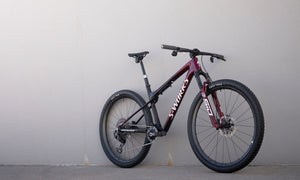
Bikes, Latest, MTB Apr 5, 2024
This Specialized S-Works Epic World Cup Is My Perfect Leadville Bike

FAQs, Guides, Latest, MTB Apr 3, 2024
FAQ: Top 5 Mountain Bikes That Hold Their Value
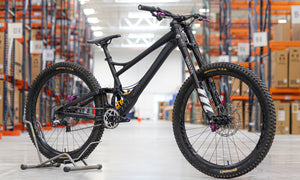
Bikes, Features, Latest, MTB Mar 15, 2024
Banshee Legend DH Bike Review: A Privateer’s Dream Bike
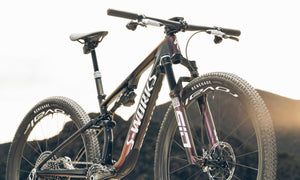
Features, Latest, MTB, Tech Mar 12, 2024
RockShox Flight Attendant: Will XC Welcome Its New Electronic Overlords?
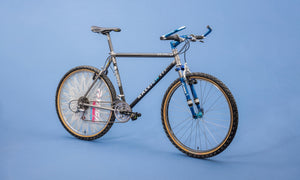
Bikes, Features, Latest, MTB, Vintage Jan 24, 2024
The Tioga Racer: 1993 Raleigh John Tomac Signature Ti/Carbon

Features, Fun, MTB Jan 4, 2024
Rage Against the Machine Likes Mountain Biking

Bikes, Features, MTB Nov 29, 2023
The Cannondale F-Si Throwback Might Be the Most Beautiful XC Hardtail Ever
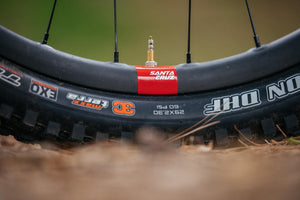
Guides, MTB, Tech Nov 28, 2023
Carbon MTB Wheels: Are They Worth It vs. Aluminum MTB Wheels
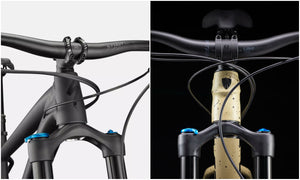
Guides, MTB Nov 14, 2023
The Best Trail Hardtail: Specialized Fuse Expert 29 vs. Trek Roscoe 9
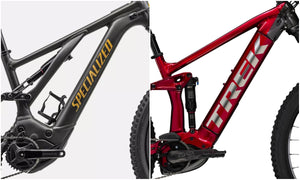
E-BikeMTB, Guides, MTB Nov 10, 2023
Budget E-MTBs: Specialized Turbo Levo Alloy vs. Trek Rail 5
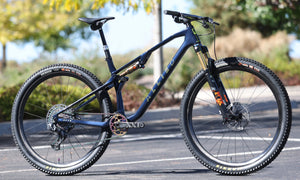
Bikes, Features, MTB Nov 9, 2023
Allied BC40: A High Caliber American-Made Downcountry Weapon
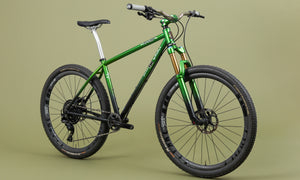
Bikes, Features, MTB Nov 1, 2023
This Fat Chance Yo Eddy Team Is a Classic 90s MTB Reborn
New arrivals.
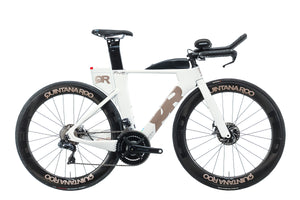
Certified Pre-Owned
Quintana Roo PRfive Disc Ultegra Triathlon Bike - 2020, 48cm
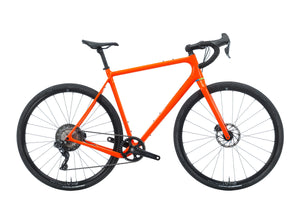
OPEN WI.DE. Gravel Bike - Large

Pinarello Prince Disk Ultegra Road Bike - 2019, 53cm
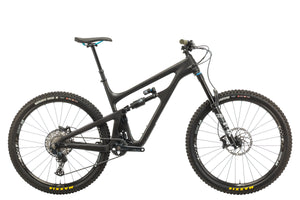
Yeti Cycles SB150 C1 Mountain Bike - 2021, X-Large
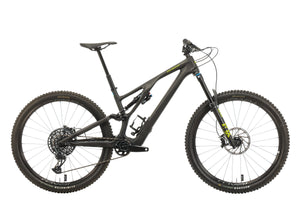
Specialized Stumpjumper Evo Expert Mountain Bike - 2022, S4
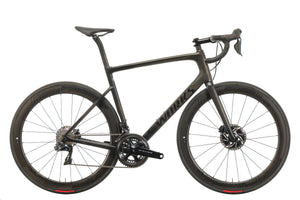
Specialized S-Works Tarmac SL6 Road Bike - 2020, 58cm
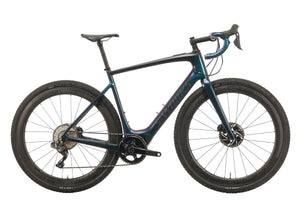
Specialized S-Works Turbo Creo SL Road E-Bike - 2020, X-Large
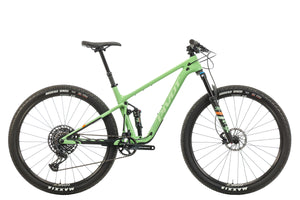
Pivot Mach 4 SL Mountain Bike - 2023, Medium
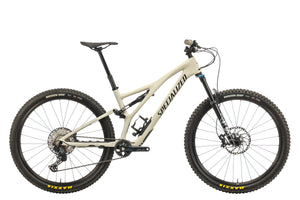
Specialized Stumpjumper Comp Mountain Bike - 2020, S4
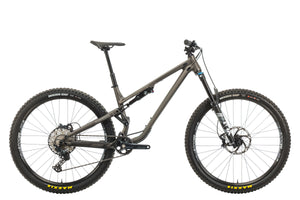
Commencal META TR Essential Mountain Bike - 2022, Medium
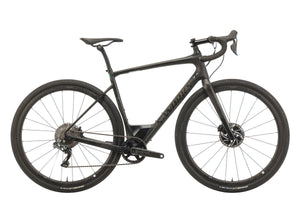
Specialized S-Works Diverge Gravel Bike - 2018, 58cm
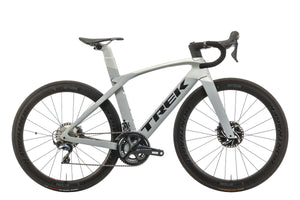
Trek Madone SLR 6 Road Bike - 2019, 52cm

What Does TRAVEL Mean on a Mountain Bike: Is More Travel Better?

I love riding my mountain bike down steep hills and off of lifts but I have noticed that even after adjusting my current suspension I am bottoming out on relatively small drops. That is why I decided to upgrade my suspension to have more travel distance. In this guide I will explain what that means for various kinds of bikes and suspension set ups.
What is “Travel” on a Mountain Bike?
Travel is simply the maximum distance that either the front or rear suspension of the Mountain Bike can compress, when absorbing force, before bottoming out. The higher the travel the more force the suspension can comfortably absorb. The lower amount of travel the lower amount of force absorbed.

Types of Mountain Bike Suspension
There are three types of suspension setups that any Mountain Bike might have (I will get into the third later). For right now it is most likely that your bike will either have a “Hard-Tail” or “Full Suspension” setup.
The difference between a hard-tail and a full suspension mountain bike is that on a full suspension bike there is a rear shock absorber as opposed to just the front fork. A hard-tail, therefore, will not have rear suspension components and will simply have a “hard” rear frame.

The differences between hard-tail and full suspension…
Price: A full suspension mountain bike will be much more expensive than a hard-tail mountain bike.
Comfort / Downhill Capability: A full suspension mountain bike is going to be much more comfortable to ride and be able to handle much higher drops. Although, this does come at the cost of reduced ability to put power into the trail.
Weight: A full suspension is going to add the components to your mountain bike so by definition will be heavier than a hard-tail
Maintenance: Again, the more parts you add the more that can go wrong and the more that needs to be adjusted.
Given this distinction between hard-tail and full suspension mountain bikes the next two sections are going to be split between talking about front and rear suspension components.
Suspension is Fun to Talk About
- Mountain Bike Travel – Read What is Travel on a MTB and is More Better?
- What is Lockout on a Mountain Bike Fork – all about when to use it.
- Selecting a MTB fork is confusing, let me help with – C hoosing a Mountain Bike Suspension Fork
- Wheels and Hub widths – Why is this so confusing? Read – How to Adapt a MTB Wheel to a Boost Fork
Front Suspension and Travel Distance on an MTB

The front suspension, or forks, of any mountain bike is going to be split into a few components. The steerer tube which goes into the center of the crown which branches into two stanchions. These stanchions are what slide into the brace and slider which ends in two dropouts that attach to the wheel.
The main way that riders upgrade their front suspension is by increasing the travel of the stanchions. In essence, this is increasing the length of compression that the front suspension withstands. A shorter travel will be more responsive and allow you to put more power into the trail while a longer suspension is better for rough trails and high lifts.
Here is a chart of common travel distances on the front suspension of the mountain bike…
Another thing that is important to keep in mind is the diameter of the stanchion tubes. As the amount of travel increases so does the diameter of the stanchion to maintain durability and stability.
Here is a chart of the common stanchion tube diameters on the front suspension of the mountain bike…
As I mention before, many riders will upgrade their mountain bikes front suspension by increasing the amount of travel that the suspension is capable of. This is really only done in two scenarios as if it is done without thought then it could actually hamper performance.
- When you have anything other than a downhill mountain bike and want to try to imitate one.
- This one kind of ties in with the previous. But, travel distance is increased when a rider desires a more comfortable ride and intends to do mostly downhill riding with large drops. If there is a large amount of uphill riding then a long travel will only make it more difficult to ride the bike.
Something that is often mentioned on MTB suspension is a “Lockout” I explained what it is and when to use your lockout in another article on this website: What is a Lockout Fork and When to Use It
Rear Suspension and Travel Distance
Now this is where things can get really complicated. This is because there are around five main rear suspension designs that manufactures implement in mountain bikes. They are as follows…
Single Pivot: In this design the rear shock of the mountain bike is connected to a swingarm by the titular single pivot point located just above the chain rings. This is the simplest rear suspension design and therefore is often the cheapest to manufacture.

The downside of the design is that the compression is going to be consistent throughout the travel of the shock as opposed to some newer designs which increase the stiffness of the rear shock as it becomes more and more compressed to hopefully prevent bottoming out.
Linkage-Driven Single Pivot: In this design there is still a swingarm connected to a single pivot point. The difference is that there is some kind of linkage which allows the manufacturers to manipulate the compression curve which was previously constant throughout the travel.
Horst-Link / Four Bar: Put simply, the rear axle of the mountain bike is not directly connected to the mainframe of the bike. This will reduce pedal bob (the bob that comes from the rhythmic nature of pedaling) and will also allow the manufacturer to manipulate the compression arc (amount of force needed to compress throughout the travel of the shock.
Twin-Link / Virtual Pivot Point: This design implements a triangular design that connects to the mainframe by two pivoting links. This design performs very similar to the Horst-Link but is not patented so is often cheaper to manufacture.
High Pivot: This is the same as the single pivot with the exception that the pivot point is placed much higher on the frame. There is also the addition of an idler pully which routs the path of the chain above the pivot point as to eliminate what would otherwise result in extremely high levels of pedal bob.

Can I Put 27.5-inch Wheels on a 26-inch Wheel MTB?

Should I Buy a 26-Inch Mountain Bike?

Who is a 26-Inch Mountain Bike Good For?
The rear shock and how it is sized.
The rear shock of the mountain bike is comprised of a single compression chamber as opposed to the front suspension which relies on two. The shock is placed horizontal (Often with a slight diagonal tilt) to the ground, again as opposed to the front suspension which is placed vertically to the ground.
Furthermore, the rear shock attaches to the frame of the bike by two eyelets which is actually how they (the shocks) are sized. Although, the same style shock is used no matter the design of your rear suspension.
Finding the Correct Eye-to-Eye Length of a Mountain Bike Rear Shock:
To find the eye-to-eye distance measure from the center of one pivot eyelet on the shock to the second one. This distance is the eye-to-eye length that you must use to find correctly sized rear shocks for your mountain bike.
Using shocks with incorrect eye-to-eye lengths can cause problems with the efficiency of the suspension and even can cause it to work against you. The travel on a rear shock is therefore more restricted although can vary slightly as the compression chamber can be of slightly different sized even if the overall length must be the same.
Just as with the front shock the longer the travel the better the shock will be at absorbing force, and the worse it will be for riding your mountain bike uphill (putting power to the trail).
MTB Tools I Love and Recommend
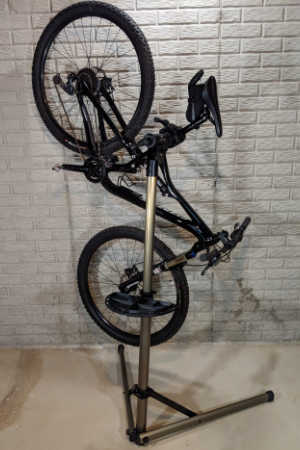
I own each of these tools and only recommend things I own and use.
- Bike Hand Bike Repair Stand . Nice mountain bikes don’t have a kick stand so keeping your MTB safe but conveniently stored is essential. I keep my bike on my stand whenever I’m not riding it. This makes it easy to lube the chain, inflate the tires and adjust the derailleur. Highly recommended – Bike Hand Bike Repair Stand (👈 Link to Amazon to see what thousands of others have said)
- A basic MTB toolbox for replacing a chain, adjusting brakes and dialing in the fit. Bike Hand has a 37-piece box that has most of the specialty bike tools to keep your MTB properly maintained. The Bike Hand brand is value packed for the avid rider. Check out the competitive prices with this link to Amazon 👉 Bike Hand 37 pcs Bike Repair Tool Kit
- Get a good air pressure gauge, if you get just a tiny bit serious about MTBing you’re going to start playing with tire pressure. A couple psi can make your tires sticking or not. Get a good gauge, I highly recommend the Topeak Smartgauge D2 , it’s accurate, flexible and easy to use. An Amazon best seller, here’s a link 👉 Topeak Smartgauge D2
- Carry a multitool with you on every ride. I’m serious, most of the time you can MacGyver something to get back to the trailhead if you have a multitool. I’ve got the Crank Brothers M19 , it’s worn, rubbed and abused – but it still works. Thousands sold on Amazon – check it out with this link 👉 Crank Brothers M19
How to Balance Your Suspension with a Full Suspension Mountain Bike
Balancing the amount of force that the front and rear suspensions on a full suspension mountain bike is crucial to getting the most out of said mountain bike. If one component is compressing slower or faster than the other then the comfort of the ride can be dramatically compromised. As can the overall effectiveness of the suspension system.
It is not essential that the front and rear suspensions have the exact same amount of travel although the closer they are the easier it will be to balance them. Balancing them involves adjusting the pressure inside of the chambers so that each shock, no matter the travel, bottoms out at the same time. A longer shock will need less pressure when paired with a shorter shock and vice versa.
Coil Shocks VS Air Shocks
There are two main kinds of suspension. Those which rely on springs to compress and those which rely on compressed air. The benefits of an air shock are that it is lightweight, easily tune-able, and naturally get stiffer near the point of bottoming out. The downsides are that they require more maintenance and are also not as responsive.
The reason why some rider chooses coil springs, even though they must be bought specific to the weight of the rider and are also heavier, is that they are extremely responsive. Additionally, coil springs don’t fade in stiffness when riding for long periods of time as some air coils will.
The Third Kind of Mountain Bike Suspension Setup (A Rigid Bike)

The third, and most uncommon, form of suspension on a mountain bike is… well… to not have one at all. On a rigid bike you will not find either a front or rear suspension system and rather just a solid frame comprising the entire mountain bike.
This kind of mountain bike setup is most widely used for fat tire bikes as with a fat tire bike it is absolutely necessary to be able to put a lot of power from the pedals into the trail. This is because of the friction accosted with a fat tire.
Rigid suspension systems on fat tire bikes are able to be implemented due to the natural suspension capabilities of having such a large tire. This larger tire works to absorb force and the low pressure you can ride at work to smooth out the ride as well.
Additionally, often time rider will upgrade their rigid style mountain bikes with increased cushion seats.
Some regular tire mountain bikes implement a rigid style suspension system although they are much less comfortable to ride and require a more experienced rider. These bikes can provide a great experience if you’re constantly going uphill and don’t plan to encounter any rough terrain.

David Humphries is the creator of DIY Mountain Bike. For me a relaxing day involves riding my mountain bike to decompress after a long day. When not on my bike I can be found wrenching on it or making YouTube videos at 👉 DIY Mountain Bike Read more about David HERE .
Looking for more How To MTB articles? Click -> HERE
- Cambridge Dictionary +Plus
Meaning of suspension in English
Your browser doesn't support HTML5 audio
suspension noun ( STOP )
- There were calls for the suspension of parliament .
- The suspension of hostilities allowed both sides to come to the negotiating table .
- Staff are furious about a suspension of their flexible working scheme .
- The school allows a partial suspension of its rules on the last day of term .
- adjournment
- asynchronously
- break-journey
- comfort stop
- hold something in abeyance
- in abeyance
- intermission
- non-continuous
- postponement
You can also find related words, phrases, and synonyms in the topics:
suspension noun ( VEHICLE )
- biting point
- carburation
- carburettor
- distributor
- internal combustion engine
- manual transmission
- water-cooled
suspension noun ( LIQUID )
- absorptive capacity
- absorptivity
- acidification
- endothermic reaction
- exothermic reaction
- fermentation
suspension | American Dictionary
Suspension | business english, examples of suspension, collocations with suspension.
These are words often used in combination with suspension .
Click on a collocation to see more examples of it.
Translations of suspension
Get a quick, free translation!

Word of the Day
a name someone uses instead of their real name, especially on a written work

Hidden in plain sight: words and phrases connected with hiding

Learn more with +Plus
- Recent and Recommended {{#preferredDictionaries}} {{name}} {{/preferredDictionaries}}
- Definitions Clear explanations of natural written and spoken English English Learner’s Dictionary Essential British English Essential American English
- Grammar and thesaurus Usage explanations of natural written and spoken English Grammar Thesaurus
- Pronunciation British and American pronunciations with audio English Pronunciation
- English–Chinese (Simplified) Chinese (Simplified)–English
- English–Chinese (Traditional) Chinese (Traditional)–English
- English–Dutch Dutch–English
- English–French French–English
- English–German German–English
- English–Indonesian Indonesian–English
- English–Italian Italian–English
- English–Japanese Japanese–English
- English–Norwegian Norwegian–English
- English–Polish Polish–English
- English–Portuguese Portuguese–English
- English–Spanish Spanish–English
- English–Swedish Swedish–English
- Dictionary +Plus Word Lists
- suspension (STOP)
- suspension (VEHICLE)
- suspension (LIQUID)
- American Noun
- Business Noun
- Collocations
- Translations
- All translations
To add suspension to a word list please sign up or log in.
Add suspension to one of your lists below, or create a new one.
{{message}}
Something went wrong.
There was a problem sending your report.
An official website of the United States government Here's how you know
Official websites use .gov A .gov website belongs to an official government organization in the United States.
Secure .gov websites use HTTPS A lock ( Lock A locked padlock ) or https:// means you’ve safely connected to the .gov website. Share sensitive information only on official, secure websites.
Biden-Harris Administration Announces Final Rule Requiring Automatic Refunds of Airline Tickets and Ancillary Service Fees
Rule makes it easy to get money back for cancelled or significantly changed flights, significantly delayed checked bags, and additional services not provided
WASHINGTON – The Biden-Harris Administration today announced that the U.S. Department of Transportation (DOT) has issued a final rule that requires airlines to promptly provide passengers with automatic cash refunds when owed. The new rule makes it easy for passengers to obtain refunds when airlines cancel or significantly change their flights, significantly delay their checked bags, or fail to provide the extra services they purchased.
“Passengers deserve to get their money back when an airline owes them - without headaches or haggling,” said U.S. Transportation Secretary Pete Buttigieg . “Our new rule sets a new standard to require airlines to promptly provide cash refunds to their passengers.”
The final rule creates certainty for consumers by defining the specific circumstances in which airlines must provide refunds. Prior to this rule, airlines were permitted to set their own standards for what kind of flight changes warranted a refund. As a result, refund policies differed from airline to airline, which made it difficult for passengers to know or assert their refund rights. DOT also received complaints of some airlines revising and applying less consumer-friendly refund policies during spikes in flight cancellations and changes.
Under the rule, passengers are entitled to a refund for:
- Canceled or significantly changed flights: Passengers will be entitled to a refund if their flight is canceled or significantly changed, and they do not accept alternative transportation or travel credits offered. For the first time, the rule defines “significant change.” Significant changes to a flight include departure or arrival times that are more than 3 hours domestically and 6 hours internationally; departures or arrivals from a different airport; increases in the number of connections; instances where passengers are downgraded to a lower class of service; or connections at different airports or flights on different planes that are less accessible or accommodating to a person with a disability.
- Significantly delayed baggage return: Passengers who file a mishandled baggage report will be entitled to a refund of their checked bag fee if it is not delivered within 12 hours of their domestic flight arriving at the gate, or 15-30 hours of their international flight arriving at the gate, depending on the length of the flight.
- Extra services not provided: Passengers will be entitled to a refund for the fee they paid for an extra service — such as Wi-Fi, seat selection, or inflight entertainment — if an airline fails to provide this service.
DOT’s final rule also makes it simple and straightforward for passengers to receive the money they are owed. Without this rule, consumers have to navigate a patchwork of cumbersome processes to request and receive a refund — searching through airline websites to figure out how make the request, filling out extra “digital paperwork,” or at times waiting for hours on the phone. In addition, passengers would receive a travel credit or voucher by default from some airlines instead of getting their money back, so they could not use their refund to rebook on another airline when their flight was changed or cancelled without navigating a cumbersome request process.
The final rule improves the passenger experience by requiring refunds to be:
- Automatic: Airlines must automatically issue refunds without passengers having to explicitly request them or jump through hoops.
- Prompt: Airlines and ticket agents must issue refunds within seven business days of refunds becoming due for credit card purchases and 20 calendar days for other payment methods.
- Cash or original form of payment: Airlines and ticket agents must provide refunds in cash or whatever original payment method the individual used to make the purchase, such as credit card or airline miles. Airlines may not substitute vouchers, travel credits, or other forms of compensation unless the passenger affirmatively chooses to accept alternative compensation.
- Full amount: Airlines and ticket agents must provide full refunds of the ticket purchase price, minus the value of any portion of transportation already used. The refunds must include all government-imposed taxes and fees and airline-imposed fees, regardless of whether the taxes or fees are refundable to airlines.
The final rule also requires airlines to provide prompt notifications to consumers affected by a cancelled or significantly changed flight of their right to a refund of the ticket and extra service fees, as well as any related policies.
In addition, in instances where consumers are restricted by a government or advised by a medical professional not to travel to, from, or within the United States due to a serious communicable disease, the final rule requires that airlines must provide travel credits or vouchers. Consumers may be required to provide documentary evidence to support their request. Travel vouchers or credits provided by airlines must be transferrable and valid for at least five years from the date of issuance.
The Department received a significant number of complaints against airlines and ticket agents for refusing to provide a refund or for delaying processing of refunds during and after the COVID-19 pandemic. At the height of the pandemic in 2020, refund complaints peaked at 87 percent of all air travel service complaints received by DOT. Refund problems continue to make up a substantial share of the complaints that DOT receives.
DOT’s Historic Record of Consumer Protection Under the Biden-Harris Administration
Under the Biden-Harris Administration and Secretary Buttigieg, DOT has advanced the largest expansion of airline passenger rights, issued the biggest fines against airlines for failing consumers, and returned more money to passengers in refunds and reimbursements than ever before in the Department’s history.
- Thanks to pressure from Secretary Buttigieg and DOT’s flightrights.gov dashboard, all 10 major U.S. airlines guarantee free rebooking and meals, and nine guarantee hotel accommodations when an airline issue causes a significant delay or cancellation. These are new commitments the airlines added to their customer service plans that DOT can legally ensure they adhere to and are displayed on flightrights.gov .
- Since President Biden took office, DOT has helped return more than $3 billion in refunds and reimbursements owed to airline passengers – including over $600 million to passengers affected by the Southwest Airlines holiday meltdown in 2022.
- Under Secretary Buttigieg, DOT has issued over $164 million in penalties against airlines for consumer protection violations. Between 1996 and 2020, DOT collectively issued less than $71 million in penalties against airlines for consumer protection violations.
- DOT recently launched a new partnership with a bipartisan group of state attorneys general to fast-track the review of consumer complaints, hold airlines accountable, and protect the rights of the traveling public.
- In 2023, the flight cancellation rate in the U.S. was a record low at under 1.2% — the lowest rate of flight cancellations in over 10 years despite a record amount of air travel.
- DOT is undertaking its first ever industry-wide review of airline privacy practices and its first review of airline loyalty programs.
In addition to finalizing the rules to require automatic refunds and protect against surprise fees, DOT is also pursuing rulemakings that would:
- Propose to ban family seating junk fees and guarantee that parents can sit with their children for no extra charge when they fly. Before President Biden and Secretary Buttigieg pressed airlines last year, no airline committed to guaranteeing fee-free family seating. Now, four airlines guarantee fee-free family seating, and the Department is working on its family seating junk fee ban proposal.
- Propose to make passenger compensation and amenities mandatory so that travelers are taken care of when airlines cause flight delays or cancellations.
- Expand the rights for passengers who use wheelchairs and ensure that they can travel safely and with dignity . The comment period on this proposed rule closes on May 13, 2024.
The final rule on refunds can be found at https://www.transportation.gov/airconsumer/latest-news and at regulations.gov , docket number DOT-OST-2022-0089. There are different implementation periods in this final rule ranging from six months for airlines to provide automatic refunds when owed to 12 months for airlines to provide transferable travel vouchers or credits when consumers are unable to travel for reasons related to a serious communicable disease.
Information about airline passenger rights, as well as DOT’s rules, guidance and orders, can be found at https://www.transportation.gov/airconsumer .

An official website of the United States government
Here’s how you know
The .gov means it’s official. Federal government websites often end in .gov or .mil. Before sharing sensitive information, make sure you’re on a federal government site.
The site is secure. The https:// ensures that you are connecting to the official website and that any information you provide is encrypted and transmitted securely.
Take action
- Report an antitrust violation
- File adjudicative documents
- Find banned debt collectors
- View competition guidance
- Competition Matters Blog
New HSR thresholds and filing fees for 2024
View all Competition Matters Blog posts
We work to advance government policies that protect consumers and promote competition.
View Policy
Search or browse the Legal Library
Find legal resources and guidance to understand your business responsibilities and comply with the law.
Browse legal resources
- Find policy statements
- Submit a public comment

Vision and Priorities
Memo from Chair Lina M. Khan to commission staff and commissioners regarding the vision and priorities for the FTC.
Technology Blog
Consumer facing applications: a quote book from the tech summit on ai.
View all Technology Blog posts
Advice and Guidance
Learn more about your rights as a consumer and how to spot and avoid scams. Find the resources you need to understand how consumer protection law impacts your business.
- Report fraud
- Report identity theft
- Register for Do Not Call
- Sign up for consumer alerts
- Get Business Blog updates
- Get your free credit report
- Find refund cases
- Order bulk publications
- Consumer Advice
- Shopping and Donating
- Credit, Loans, and Debt
- Jobs and Making Money
- Unwanted Calls, Emails, and Texts
- Identity Theft and Online Security
- Business Guidance
- Advertising and Marketing
- Credit and Finance
- Privacy and Security
- By Industry
- For Small Businesses
- Browse Business Guidance Resources
- Business Blog
Servicemembers: Your tool for financial readiness
Visit militaryconsumer.gov
Get consumer protection basics, plain and simple
Visit consumer.gov
Learn how the FTC protects free enterprise and consumers
Visit Competition Counts
Looking for competition guidance?
- Competition Guidance
News and Events
Latest news, ftc order bans former pioneer ceo from exxon board seat in exxon-pioneer deal.
View News and Events
Upcoming Event
Older adults and fraud: what you need to know.
View more Events
Sign up for the latest news
Follow us on social media
--> --> --> --> -->

Playing it Safe: Explore the FTC's Top Video Game Cases
Learn about the FTC's notable video game cases and what our agency is doing to keep the public safe.
Latest Data Visualization

FTC Refunds to Consumers
Explore refund statistics including where refunds were sent and the dollar amounts refunded with this visualization.
About the FTC
Our mission is protecting the public from deceptive or unfair business practices and from unfair methods of competition through law enforcement, advocacy, research, and education.
Learn more about the FTC

Meet the Chair
Lina M. Khan was sworn in as Chair of the Federal Trade Commission on June 15, 2021.
Chair Lina M. Khan
Looking for legal documents or records? Search the Legal Library instead.
- Cases and Proceedings
- Premerger Notification Program
- Merger Review
- Anticompetitive Practices
- Competition and Consumer Protection Guidance Documents
- Warning Letters
- Consumer Sentinel Network
- Criminal Liaison Unit
- FTC Refund Programs
- Notices of Penalty Offenses
- Advocacy and Research
- Advisory Opinions
- Cooperation Agreements
- Federal Register Notices
- Public Comments
- Policy Statements
- International
- Office of Technology Blog
- Military Consumer
- Consumer.gov
- Bulk Publications
- Data and Visualizations
- Stay Connected
- Commissioners and Staff
- Bureaus and Offices
- Budget and Strategy
- Office of Inspector General
- Careers at the FTC
Fact Sheet on FTC’s Proposed Final Noncompete Rule
- Competition
- Office of Policy Planning
- Bureau of Competition
The following outline provides a high-level overview of the FTC’s proposed final rule :
- Specifically, the final rule provides that it is an unfair method of competition—and therefore a violation of Section 5 of the FTC Act—for employers to enter into noncompetes with workers after the effective date.
- Fewer than 1% of workers are estimated to be senior executives under the final rule.
- Specifically, the final rule defines the term “senior executive” to refer to workers earning more than $151,164 annually who are in a “policy-making position.”
- Reduced health care costs: $74-$194 billion in reduced spending on physician services over the next decade.
- New business formation: 2.7% increase in the rate of new firm formation, resulting in over 8,500 additional new businesses created each year.
- This reflects an estimated increase of about 3,000 to 5,000 new patents in the first year noncompetes are banned, rising to about 30,000-53,000 in the tenth year.
- This represents an estimated increase of 11-19% annually over a ten-year period.
- The average worker’s earnings will rise an estimated extra $524 per year.
The Federal Trade Commission develops policy initiatives on issues that affect competition, consumers, and the U.S. economy. The FTC will never demand money, make threats, tell you to transfer money, or promise you a prize. Follow the FTC on social media , read consumer alerts and the business blog , and sign up to get the latest FTC news and alerts .
Press Release Reference
Contact information, media contact.
Victoria Graham Office of Public Affairs 415-848-5121
Middle East Crisis Turkey Halts Trade With Israel as Relations Deteriorate
- Share full article
![travel suspension definition [object Object]](https://static01.nyt.com/images/2024/05/02/multimedia/02mideast-crisis-carousel-01-jkpg/02mideast-crisis-carousel-01-jkpg-square640.jpg?quality=75&auto=webp)
- An Israeli soldier near the border with the Gaza Strip. Amir Cohen/Reuters
- Activists in Tel Aviv blocking a highway to demand the release of hostages held in Gaza. Jack Guez/Agence France-Presse — Getty Images
- Workers at the damaged Nasser Hospital in Khan Younis. Agence France-Presse — Getty Images
- A Palestinian vendor preparing falafel in Khan Younis. Agence France-Presse — Getty Images
- A Palestinian who had been detained by the Israeli military and later released receiving treatment at a hospital in Rafah. Hatem Khaled/Reuters
- A message in Rafah in southern Gaza thanking pro-Palestinian protesters on college campuses in the United States. Mohammed Salem/Reuters
- A destroyed neighborhood in Khan Younis. Agence France-Presse — Getty Images
The Turkish president has strongly criticized the Israeli bombardment of Gaza.
Turkey said late Thursday that it had halted all trade with Israel until “uninterrupted and adequate humanitarian aid is allowed into Gaza,” signaling further deterioration in relations between the two countries.
Turkey’s Trade Ministry said in a statement that exports and imports “for all products” would pause.
The move, which was initially reported by Bloomberg , had prompted the Israeli foreign minister, Israel Katz, to lash out at Turkey’s president, Recep Tayyip Erdogan, accusing him of “blocking ports for Israeli imports and exports.”
“This is how a dictator behaves, disregarding the interests of the Turkish people and businessmen, and ignoring international trade agreements,” Mr. Katz added in a post on X , the social media platform. Mr. Katz also said he had instructed the Foreign Ministry to create alternatives for trade with Turkey, focusing on local production and imports from other countries.
Turkey reported $5.4 billion in exports to Israel in 2023 and $1.64 billion in imports, according to United Nations figures.
Mr. Erdogan did not comment publicly on any changes in Turkey’s trade ties with Israel. But the Turkish leader has strongly criticized Israel’s bombardment of Gaza, which began after Hamas led an Oct. 7 attack into Israel that killed about 1,200 people and led to the abduction of about 240 others. More than 34,000 Palestinians have been killed amid Israel’s bombardment of the territory, according to health officials in the territory.
The Turkish leader has also forcefully defended Hamas and recently met with Ismail Haniyeh, the group’s political leader, and other Hamas officials in Istanbul on April 20. Mr. Erdogan told reporters then, “Israel will certainly pay the price of the atrocities it has been inflicting on Palestinians one day.”
The decision by Turkey to halt trade came after its Trade Ministry imposed export restrictions on Israel on April 9 in 54 product groups, including cement and jet fuel, and said they would remain in force until “Israel declares an immediate cease-fire in Gaza.”
The Trade Ministry defined Thursday’s suspension as “the second step in intergovernmental measures” and cited “worsening humanitarian tragedy in Palestine.”
The Turkish foreign minister, Hakan Fidan, also announced on Wednesday that Turkey would join South Africa’s genocide case against Israel at the International Court of Justice. In a preliminary decision in January, the court ordered Israel to ensure that its forces were not committing genocide in Gaza.
— Gulsin Harman and Ben Hubbard reporting from Istanbul
Hopes rise among relatives of hostages as signs of progress in talks are reported.
Dozens of family members of Israeli hostages and their supporters gathered in protest on Thursday opposite the Israeli military’s headquarters in Tel Aviv while the country’s war cabinet convened there to discuss, among other things, developments in talks aimed at securing the release of the captives.
The protesters blocked a sidewalk near the building where Israel’s top officials were meeting and, using loudspeakers, they counted to 209 — the number of days that had passed since the hostages were seized on Oct. 7. They called on Prime Minister Benjamin Netanyahu to agree to a deal that would secure the remaining hostages’ release, no matter how costly.
“Tension is very high,” said Shay Dickmann, the cousin of Carmel Gat, one of the hostages still in Gaza. “Whenever there’s talk about a deal our heart opens.”
Many of the relatives of hostages have staged similar demonstrations to Thursday’s in the months since their loved ones were taken captive. But in the last several days, they have experienced especially tense anticipation, clinging to reports indicating progress in the negotiations with Hamas.
But others in Israel — including right-wing lawmakers like Bezalel Smotrich, the country’s finance minister — have expressed disdain about the concessions the government would have to make to secure such a deal. Israel has recently said it would agree to the release of fewer hostages in exchange for a cease-fire and the release of Palestinian prisoners .
The proposal’s detractors have also raised concerns that a cease-fire would interfere with a planned ground incursion into Rafah, the southern Gaza city that Israel’s government maintains is the last stronghold of Hamas. Far-right members of Israel’s governing coalition have threatened to bring down Mr. Netanyahu’s administration if the war ends without Hamas’s total defeat.
Ms. Dickmann said she realized that the concessions Israel would have to make to reach a deal were difficult to accept but that they were “worth the lives that can still be saved.”
“I want to believe my country cares about my cousin’s life,” she said.
— Johnatan Reiss
U.N. report says rebuilding all the homes destroyed in Gaza could take 80 years.
Rebuilding all the homes destroyed by Israel’s military offensive in the Gaza Strip could take until the next century if the pace of reconstruction were to match what it was after wars there in 2014 and 2021, according to a United Nations report released on Thursday.
Citing data from the Palestinian Central Bureau of Statistics, the U.N. report said that as of April 15, some 370,000 homes in Gaza had been damaged, 79,000 of which have been destroyed. If those destroyed homes were rebuilt at the same pace as they were after the two previous wars — an average of 992 per year — it would take 80 years, according to projections in the report from the United Nations Development Program and the United Nations Economic and Social Commission for Western Asia.
The report detailed the war’s socioeconomic impact on the Palestinian population and said “the level of destruction in Gaza is such that the required assistance to rebuild would be on a scale not seen since 1948” to replace public infrastructure, including schools and hospitals.
The report said that even if Israel were to allow five times as much construction material into Gaza after this war as it did after the war in 2021 — “the most optimistic scenario” — rebuilding all of the destroyed homes would still take until 2040. That projection does not account for the time it would take to repair the hundreds of thousands of homes that were damaged but not destroyed.
The cost of rebuilding Gaza is increasing “exponentially” each day the fighting continues, Abdallah Al Dardari, the director of the U.N.D.P.’s regional bureau for Arab states, speaking over a video call from Amman, Jordan, said at a news conference on Thursday.
Mr. Al Dardari said that before “some sort of normalcy” can be established for Palestinians in Gaza, an estimated 37 million tons of debris must be cleared to allow for the construction of temporary shelters and, eventually, the rebuilding of homes.
The report also found that the unemployment rate for Palestinians across the occupied West Bank, East Jerusalem and Gaza surged to roughly 46 percent from about 26 percent after six months of war.
Over those six months, poverty rates in the Palestinian territories more than doubled, to an estimated 57.2 percent from 26.7 percent. That means 1.67 million Palestinians were pushed into poverty after the war began, the report said. Its estimates were based on a poverty line of $6.85 a day.
The effects of the war on Palestinians both in and out of Gaza “will be felt for years,” the report said.
— Anushka Patil
The U.S. and Israel say the fate of a cease-fire deal rests with Hamas.
With the United States and Israel insisting that the fate of a Gaza cease-fire deal is in the hands of Hamas, the leader of the group’s political wing said on Thursday that it was studying Israel’s latest proposal with a “positive spirit,” and would soon return to in-person negotiations.
The proposal, after almost seven devastating months of war, includes the release of hostages held by Hamas and Palestinian prisoners in Israel, and the return of civilians to the largely depopulated northern part of Gaza. It would also allow for increased delivery of aid to the territory.
On Thursday, the Hamas leader, Ismail Haniyeh, told an Egyptian official that his group was examining the proposal. A Hamas delegation will go to Egypt soon to “complete the ongoing discussions” for a deal that “realizes our people’s demands and ends the aggression,” according to a statement from the group.
Less than a day earlier, a Hamas spokesman, Osama Hamdan, had said on Lebanese television that “our position on the current negotiating paper is negative.” But the Hamas press office later said his comment was not an outright rejection. Some changes would need to be made for Hamas to agree, the office said, without elaborating.
In Israel, the war cabinet met on Thursday evening to discuss the cease-fire negotiations and a planned Israeli invasion of Rafah, the southernmost city in Gaza, where around a million people have been sheltering, according to an Israeli official who requested anonymity because they were not authorized to communicate with the media on the matter.
On a visit to Israel on Wednesday, Secretary of State Antony J. Blinken put the onus squarely on Hamas to accept the Israeli proposal. “We are determined to get a cease-fire that brings the hostages home and to get it now, and the only reason that that wouldn’t be achieved is because of Hamas,” he said.
However, the Israeli opposition leader, Yair Lapid, said that Prime Minister Benjamin Netanyahu had “no political excuse” not to make a deal quickly.
The complex negotiations have dragged on for months, with each bargaining piece moved also shifting several others. Complicating matters further is that Israel and the United States do not talk directly with Hamas, which they consider a terrorist organization, but communicate through officials of Qatar and Egypt who act as intermediaries.
A seemingly intractable sticking point is Israel’s planned ground offensive into Rafah. “If the enemy carries out the Rafah operation, negotiations will stop,” Mr. Hamdan said on Wednesday. “The resistance does not negotiate under fire.”
The Biden administration has pressed the Israeli government hard to abandon the idea of a major invasion of the city, and to rely instead on surgical operations to kill or capture Hamas leaders and fighters.
But Israeli officials have said, consistently and emphatically, that the offensive will take place. Far-right parties in Mr. Netanyahu’s coalition have hinted at leaving it if he calls off the offensive, which could cause the government to collapse and force new elections.
“We will enter Rafah and we will eliminate the Hamas battalions there — with or without a deal — in order to achieve the total victory,” Mr. Netanyahu said in a statement released on Tuesday.
Hamas has insisted that any agreement would eventually lead to a permanent cease-fire, not just a temporary halt in the fighting — a stance that Israel has rejected as a Hamas play for time to re-establish itself as a governing and military force. The Biden administration has held out hope that a six-week pause in the war could be the first step toward a lasting end to the fighting.
Israel this week softened some of its positions. It agreed to allow Palestinians to return to northern Gaza en masse in the first phase of a cease-fire. Israel had previously insisted on screening returnees and limiting their flow.
Israel also backed away from its demand that Hamas release 40 hostages — female civilians and soldiers, and those who ill or aged — after Hamas indicated that it did not have 40 living hostages in those categories. The latest proposal lowers the figure to 33. The number of Palestinians Israel is offering to free in exchange is unclear.
In the Hamas-led Oct. 7 assault on Israel, about 250 people were kidnapped and taken back to Gaza, according to the Israeli government. More than 100 were released in a weeklong cease-fire in November, and Israeli officials say they believe that more than 30 — possibly many more — are dead.
The Oct. 7 attacks killed some 1,200 people, Israel has said. Gazan health officials say that Israel’s subsequent bombing and invasion have killed more than 34,000 people, and injured far more. Most of Gaza’s population of some 2.3 million have been displaced, and more than a million people are suffering catastrophic food insecurity, according to the United Nations .
— Adam Rasgon , Hwaida Saad , Edward Wong and Damien Cave
The lead negotiator for Hamas is the deputy to Yahya Sinwar, the group’s leader in Gaza.
As cease-fire talks appear to be gaining momentum, Hamas’s point man in negotiations is likely to be a conservative former lawmaker from the Gaza Strip who is the deputy to Yahya Sinwar, the hard-line and powerful leader of Hamas in the enclave.
The ex-lawmaker, Khalil al-Hayya, has led the Hamas delegations that met recently with Egypt’s General Intelligence Service, a key mediator that has been shuttling messages between Israel and Hamas.
Mr. Hayya, 63, who favors a salt-and-pepper beard and often goes without a tie, was most likely selected as Hamas’s top negotiator because he comes from the Gaza Strip and is close to Mr. Sinwar, the presumed mastermind of the Hamas-led attacks on Israel on Oct. 7, according to analysts.
“He’s the closest to Sinwar among the leaders in the diaspora,” said Salah al-Din al-Awawdeh, an Istanbul-based Palestinian analyst close to Hamas. “At this moment, he’s the most important link between Sinwar and the outside world.”
Mr. Hayya, a longtime resident of Gaza, left the territory before Oct. 7 and has spent much of his time in Doha, Qatar, and in Istanbul. He officially serves as Mr. Sinwar’s deputy, a position he took on after he supported Mr. Sinwar in internal elections in 2021 against a challenger who nearly unseated him, Mr. Awawdeh said.
On Thursday, Ismail Haniyeh, the chairman of Hamas’s political wing, told Abbas Kamel, the chief of Egypt’s General Intelligence Service, that Hamas was studying the latest Israeli proposal for a cease-fire with a “positive spirit” and that the group would send a delegation to Cairo to participate in talks soon, according to a statement from Hamas.
While Hamas officials have expressed skepticism about the latest Israeli proposal, it includes some concessions on longtime sticking points in the negotiations.
While Mr. Hayya has been entrusted with some latitude as a negotiator, he does not have free rein. In recent rounds of talks, Hamas officials have conducted extensive internal discussions before sharing their own proposals or responding to those of other parties.
Mr. Sinwar’s opinion has been crucial to Hamas’s ultimate responses, which have often taken hours or sometimes days to obtain, according to American officials, an Israeli official and an official familiar with the talks.
While exchanging messages with Mr. Sinwar has occasionally taken a long time, Hamas leaders abroad have also used the excuse of difficulties in communicating with him to fend off demands to provide swift responses to new proposals, Mr. Awawdeh said.
“It lessens the pressure on the movement,” he said. “Sometimes, the mediators tell Hamas leaders: ‘We need an answer immediately. We need it right now.’ The best response is to say there are no communications with Gaza.”
In a television interview last week, Mr. Hayya, a former legislator, said that the main obstacle in the negotiations was Prime Minister Benjamin Netanyahu of Israel’s government, which he asserted did not want a cease-fire.
“That’s the bottom line,” he told Ahsarq News, a Pan-Arabic television channel.
Israeli officials have expressed openness to a temporary pause in the fighting, but have repeatedly said that a ground offensive in Rafah — the southernmost city in Gaza, where around one million people have taken shelter — was necessary in order to destroy several Hamas battalions there.
Mr. Hayya, who has lost several family members in the Israeli-Palestinian conflict, is seen as a by-the-book Hamas institutionalist who has no history of corruption, unlike some other officials in the organization, analysts said.
“He represents the movement’s position completely: He doesn’t veer away from it at all,” Mr. Awawdeh said.
He also has a reputation for being less extreme than some other leaders in the Hamas hierarchy, who support no compromise with Israel. “He’s not radical,” said Hussam Dajani, a Gaza-based analyst.
Julian Barnes contributed reporting to this article.
— Adam Rasgon Reporting from Jerusalem
Biden denounces violence on campuses, breaking his silence after a rash of arrests.
President biden addresses campus protests, president biden defended the right of demonstrators to protest peacefully, but condemned the “chaos” that has prevailed at many colleges nationwide..
Violent protest is not protected. Peaceful protest is. It’s against the law when violence occurs. Destroying property is not a peaceful protest. It’s against the law. Vandalism, trespassing, breaking windows, shutting down campuses, forcing the cancellation of classes and graduations — none of this is a peaceful protest. Threatening people, intimidating people, instilling fear in people is not peaceful protest. It’s against the law. Dissent is essential to democracy, but dissent must never lead to disorder or to denying the rights of others, so students can finish the semester and their college education. There’s the right to protest, but not the right to cause chaos. People have the right to get an education, the right to get a degree, the right to walk across the campus safely without fear of being attacked. But let’s be clear about this as well. There should be no place on any campus — no place in America — for antisemitism or threats of violence against Jewish students. There is no place for hate speech or violence of any kind, whether it’s antisemitism, Islamophobia or discrimination against Arab Americans or Palestinian Americans. It’s simply wrong. There’s no place for racism in America.

President Biden broke days of silence on Thursday to finally speak out on the wave of protests on American college campuses against Israel’s war in Gaza that have inflamed much of the country, denouncing violence and antisemitism even as he defended the right to peaceful dissent.
In a previously unscheduled televised statement from the White House, Mr. Biden offered a forceful condemnation of students and other protesters who in his view have taken their grievances over the war too far. But he rejected Republican calls to deploy the National Guard to rein in the campuses.
“There’s the right to protest, but not the right to cause chaos,” Mr. Biden said into cameras in his first personal remarks on the campus fray in 10 days. “People have the right to get an education, the right to get a degree, the right to walk across the campus safely without fear of being attacked.” Antisemitism, he added, “has no place” in America.
The president’s comments came as universities across the nation continued to struggle to restore order. Police officers in riot gear arrested about 200 people as they cleared a protest encampment at the University of California, Los Angeles, while other officers removed demonstrators occupying a library at Portland State University in Oregon. Activists erected 30 tents at the University of Wisconsin-Madison a day after the police removed tents and detained 34 people .
The confrontations on Thursday followed a tense 24 hours during which police officers made arrests at Fordham University’s Manhattan campus , the University of Texas at Dallas, Dartmouth College in New Hampshire and Tulane University in New Orleans , among other places. As of Thursday, the campus unrest had led to nearly 2,000 arrests at dozens of academic institutions in the last two weeks, according to a New York Times tally .
Administrators at some colleges, including Brown University in Rhode Island and Northwestern University in Illinois, opted to avoid conflict by striking deals with pro-Palestinian protesters to bring a peaceful end to their encampments — agreements that have drawn harsh criticism from some Jewish leaders .
The protests have erupted in response to Israel’s war in Gaza since the Oct. 7 Hamas-led terrorist attack killed 1,200 people in Israel and resulted in more than 200 taken hostage. More than 34,000 people in Gaza have been killed since then, according to authorities there, including both Hamas combatants and civilians. The protesters have demanded that the Biden administration cut off arms to Israel and that their schools divest from companies linked to Israel, but in many cases the demonstrations have included antisemitic rhetoric and harassment targeting Jewish students.
Some of those sympathetic to the protesters pushed back against administrators for resorting to police action. The Columbia University chapter of the American Association of University Professors on Thursday called for the condemnation of Nemat Shafik, the university’s president, after a police operation that removed students occupying Hamilton Hall and resulted in more than 100 arrests.
“Armed counterterrorism police on campus, student arrests and harsh discipline were not the only path through this crisis,” the group said.
The images of arrests and clashes have come to dominate the political debate in Washington in recent days as Republicans seek to position themselves as defenders of Jewish students and portray Democrats and university leaders as soft on antisemitism.
A day after the House passed a bipartisan measure seeking to codify a broader definition of antisemitism into federal education policy, with 70 Democrats and 21 Republicans voting no, a group of 20 Senate Republicans introduced their own version of the resolution.
“Antisemitism is rearing its ugly head at college campuses across our nation,” said the bill’s sponsor, Senator Tim Scott, Republican of South Carolina and a possible vice-presidential running mate for former President Donald J. Trump. “Jewish students are being targeted with violence and harassment, and the university presidents and administrators, who should be defending them, are caving to the radical mob and allowing chaos to spread.”
Mr. Trump weighed in on social media. “This is a radical left revolution taking place in our country,” he wrote in all capital letters as the confrontation at U.C.L.A. escalated. “Where is Crooked Joe Biden? Where is Governor Newscum? The danger to our country is from the left, not from the right!!!”
Gov. Gavin Newsom of California, a Democrat, issued his own statement on Wednesday. “The right to free speech does not extend to inciting violence, vandalism, or lawlessness on campus,” he said.
That was the formulation that Mr. Biden advanced during his televised comments on Thursday morning before leaving the White House for a daylong trip to North Carolina, where he met with relatives of four law enforcement officers killed in Charlotte on Monday and later gave a speech in Wilmington announcing plans to replace lead pipes.
“Destroying property is not a peaceful protest. It’s against the law,” the president said. “Vandalism, trespassing, breaking windows, shutting down campuses, forcing the cancellation of classes and graduations — none of this is a peaceful protest. Threatening people, intimidating people, instilling fear in people is not peaceful protest. It’s against the law. Dissent is essential to democracy, but dissent must never lead to disorder or to denying the rights of others so students can finish the semester and their college education.”
Mr. Biden has been pushing for an agreement between Israel and Hamas that would end the combat, at least temporarily, but a deal has remained elusive. Under a U.S.-sponsored proposal on the table, Israel would enter a cease-fire for six weeks and release hundreds of Palestinians held in its prisons while Hamas would free 33 of the more than 100 hostages it is still holding.
The president and his team hope that such a first stage would lead to a longer cessation of hostilities and the release of more hostages as well as more food, medicine and other aid to ease the humanitarian crisis in Gaza. But American officials said that while Israel has agreed to the plan, Hamas has so far refused.
The president’s four-minute statement came after some Democrats frustrated by his reluctance to speak out pressed him to publicly address the campus uprisings. Until Thursday, Mr. Biden had offered only a couple of sentences in response to reporter questions on April 22 that even Democrats considered too equivocal and otherwise left it to his spokespeople to express his views. Republicans have castigated him for not weighing in himself.
Mr. Biden implied that his critics were simply being opportunistic. “In moments like this, there are always those who rush in to score political points,” he said. “But this isn’t a moment for politics. It’s a moment for clarity. So let me be clear: Peaceful protest in America. Violent protest is not protected. Peaceful protest is.”
In calming some in his party, though, Mr. Biden took heat from others on the political left. In their view, he employed none of the nuance that he expressed in 2020 when otherwise peaceful protests after the police killing of George Floyd got out of control and Mr. Biden acknowledged root causes of the anger even while condemning violence.
“He could’ve made some effort to do the same today,” said Matt Duss, a former foreign policy adviser to Senator Bernie Sanders, the democratic socialist from Vermont. “Instead, he chose to amplify a right-wing caricature. Unfortunately, it’s consistent with an overall policy approach that shows little regard for Palestinian perspectives or Palestinian lives.”
In his statement, Mr. Biden emphasized that he would always defend free speech, even for those protesting his own support for Israel’s war. But he made clear that he thought too many of the demonstrations had gone beyond the bounds of simple speech.
“Let’s be clear about this as well,” he added. “There should be no place on any campus, no place in America, for antisemitism or threats of violence against Jewish students. There is no place for hate speech or violence of any kind, whether it’s antisemitism, Islamophobia, or discrimination against Arab Americans or Palestinian Americans.”
In response to questions by reporters, Mr. Biden said he would not change his Middle East policy as a result of the protests. Asked as he left the room if the National Guard should intervene, he said simply, “No.”
Reporting was contributed by Jonathan Wolfe from Los Angeles; Ernesto Londoño from St. Paul, Minn.; Bob Chiarito from Madison, Wis.; and Mike Baker from Seattle.
— Peter Baker Traveling with President Biden aboard Air Force One
A father in Rafah whose family survived an airstrike asks, ‘What should we do?’

As Prime Minister Benjamin Netanyahu of Israel repeats his vow to launch a ground invasion of Rafah in southern Gaza and Israeli airstrikes continue to pummel the city, it is a particularly fearful time for displaced families sheltering there.
“What should we do? Where will we go?” said Mohammed Abu Youssef, who spoke on Wednesday in video shot by the Reuters news agency about how he and his children had narrowly survived an airstrike. “I am waiting for a tent so I can leave,” he added as he burst into tears.
Mr. Abu Youssef said his family had recently fled to Al-Shaboura neighborhood in Rafah, seeking safety. He suffered a head injury in the strike, he said, and his brother-in-law, who was sheltering with him, lost two children. Several other relatives were also wounded, he said.
Roughly a million displaced Palestinians have sought shelter in Rafah from the Israeli bombardment and ground fighting that health officials say have killed more than 34,000 people across Gaza. Israel has said that the purpose of the planned invasion is to root out Hamas fighters there.
Mr. Abu Youssef said he was now left grappling with the uncertainty of again trying to find a place where his family could be safe. Some displaced families in Rafah have already been moving north into areas of Gaza that were combat zones earlier in the war.
Nader Ibrahim contributed reporting and video production from London.
— Hiba Yazbek reporting from Jerusalem
Advertisement

IMAGES
VIDEO
COMMENTS
Most mid travel systems for this platform will net around 10 inches of suspension travel with just an aftermarket UCA and coilover. Most long travel systems for this platform will net 13 inches or more of suspension travel. And depending on the components, some can attain as much as 18 inches of travel, all while retaining four wheel drive.
Simply put, suspension travel refers to how far a component of the suspension can move over the full extent of its movement range. In most cases, we're interested in the vertical wheel travel, which is the distance that the wheel can travel from full droop to full compression. However, suspension travel can also refer to any other part of the ...
Suspension travel is defined as the maximum vertical distance that the wheel can travel from the fully extended 'Rebound' condition to the fully compressed 'Full Bump' condition. 'Bump Travel' is defined as the distance traveled by the wheel center from Normal ride height to Full Bump condition. 'Rebound Travel' is defined as ...
Every suspension has this wheel travel, which must be accommodated by some means. How is the wheel movement accommodated? Springs are normally used (Figure 1.1). As the tire strikes a bump in the road, so a vertical force is applied to the spring' which is compressed or deflected. Therefore the wheel moves vertically relative to the body, and ...
Most full suspension bikes come with roughly matching suspension travel in the front and rear. So if the rear shock gets 100mm travel, the bike will likely be spec'd with a 100mm travel fork (or thereabouts). 80mm - 100mm Travel: "Cross Country" Bikes; The smallest amount of suspension that is commonly available these days is around 80mm.
Long travel suspension is a type of vehicle suspension often used in off road racing. Vehicles such as dune buggies, baja racers, mountain bikes, adventure motorcycles, dirt bikes and rock crawlers use long travel suspension to dampen the effects of, rough, off-road driving conditions. [1] There is no definitive standard on what is considered ...
A twin-tube design allows for more suspension travel in a given space compared to a monotube design, which combined with lowered gas pressure, often results in better ride characteristics. Most production car dampers are twin-tube. Most street car dampers feature a fixed spring perch and ride height. Adjustable ride height suspension, often ...
Suspension travel refers to how much the suspension can move before it is fully compressed and cannot move a millimeter further. The more the suspension can be compressed, the more the wheel can move up and down, and the longer the suspension travel is. However, the suspension spring can't be fully decompressed when the rider or anything ...
Suspension travel can be both positive or negative, based on wheel travel (Photo Credit : Pavel Vaschenkov/Shutterstock) The kinetic energy due to wheel travel is stored in the displacement unit. A shock absorber is composed of a piston moving in an oil-filled chamber. This piston moves in synchronization with the displacement unit.
04:29. The most common definition of damper motion ratio is the amount of wheel movement divided by spring movement. 04:36. In the case of a coilover type setup, the same motion ratio applies to both the spring and the damper. 04:43. The kinematics of the suspension is going to determine the motion ratio. 04:46.
The suspension design is crucial in the development of vehicle behavior to optimize vehicle performance, handling and comfort. There are a multitude of possible adjustments depending on the vehicle (comfort, sportiness, etc.). ... Positive toe (toe out) is defined as a wheel splaying out from the direction of travel. Toe Angle carries the same ...
Comparing Suspension Travel Lengths. A longer deceleration leads to lower average forces. This explains why a 1" platform of vibration-mitigating foam is inferior to a 4" travel suspension system when it comes to mitigating shocks. Likewise, a 4" travel suspension will be outperformed by its 10" counterpart. The principle applies to ...
Part of car suspension system consists of shock absorber, axle, frame and spring Part of car front suspension and steering mechanism: tie rod, steering arm, king pin axis (using ball joints). Van Diemen RF01 Racing Car Suspension.. Suspension is the system of tires, tire air, springs, shock absorbers and linkages that connects a vehicle to its wheels and allows relative motion between the two.
Anti-dive is a suspension characteristic that affects the amount of suspension travel when the brakes are applied. When a car is decelerating due to braking there is a load transfer off the rear wheels and onto the front wheels. Vehicle properties such as the center of gravity height, total weight, deceleration rate and wheelbase affect the ...
Motion ratio is the more common term in the industry, but sometimes is used to mean the inverse of the above definition. Motion ratio in suspension of a vehicle describes the amount of shock travel for a given amount of wheel travel. Mathematically, it is the ratio of shock travel and wheel travel. The amount of force transmitted to the vehicle ...
Suspension travel refers to how much movement a suspension mechanism allows and is usually a measure of how much the wheel axle moves when the suspension compresses. ... This is the commonly accepted and talked about definition. However, if you were to talk to a MTB engineer, you would get a different response, since leverage ratio would be a ...
Suspension travel is the range of motion your vehicle's suspension can utilize. To measure your actual suspension travel you must compress your suspension fully, then let your suspension extend fully and measure how much the center of the axle moves from point to point. Suspension travel is not measured by the arc of the suspension's path, but ...
The suspension position for a specific wheel may then be calculated as: where is the actual weight being supported by that wheel. Studying the oscillating behavior # The suspension properties may be studied from the point of view of the oscillating behavior (Harmonic oscillator). The associated concepts are used to study the reactions of the ...
In case you're new to riding, mountain bike suspension travel is a measurement of how much a wheel can move to absorb bumps. On the front, mountain bike travel comes from your suspension fork. At the rear, MTB travel is provided by some configuration of frame pivots that compress a rear shock. Going big is easier on my 150mm enduro bike.
Trophy Trucks travel across the desert at speeds exceeding 130 mph. Running tires up to 42-inches tall, they have solid axles in the rear with trailing arms and a wishbone. A Trophy Truck's suspension is designed for maximum suspension travel and most are able to travel as much as 36 to 40-inches.
Travel is simply the maximum distance that either the front or rear suspension of the Mountain Bike can compress, when absorbing force, before bottoming out. The higher the travel the more force the suspension can comfortably absorb. The lower amount of travel the lower amount of force absorbed. Specialized FSR Suspension.
SUSPENSION meaning: 1. the act of stopping something happening, operating, etc. for a period of time: 2. a punishment…. Learn more.
SUSPENSION definition: 1. the act of stopping something happening, operating, etc. for a period of time: 2. a punishment…. Learn more.
Travel vouchers or credits provided by airlines must be transferrable and valid for at least five years from the date of issuance. The Department received a significant number of complaints against airlines and ticket agents for refusing to provide a refund or for delaying processing of refunds during and after the COVID-19 pandemic.
Real Madrid injury and suspension news against Bayern Munich. Ancelotti will be without one key player in the form of right-back Dani Carvajal, as he will serve a suspension for picking up his ...
Fewer than 1% of workers are estimated to be senior executives under the final rule. Specifically, the final rule defines the term "senior executive" to refer to workers earning more than $151,164 annually who are in a "policy-making position.". The FTC estimates that banning noncompetes will result in: Reduced health care costs: $74 ...
for the purposes of this definition, the ter rn ... (iii) the grounds for suspension and revocation and the page 3-house bill 24-1060 . penalties applicable to resident insurance producers under ... travel protection plan's fulfillment materials by mail; or (b) ten days following the date of delivery of the travel ...
Turkey said late Thursday that it had halted all trade with Israel until "uninterrupted and adequate humanitarian aid is allowed into Gaza," signaling further deterioration in relations ...